


Your Support Team Drives More Revenue Than You Think: Conversational Commerce Metrics
TL;DR:
- Support chats can now be directly tied to revenue. Brands are measuring conversations by conversion rate, average order value (AOV), and GMV influenced.
- AI resolution rate is only valuable if the answers are accurate and helpful. A high resolution rate doesn’t matter if it leads to poor recommendations — the best AI both deflects volume and drives confident purchases.
- Chat conversion rates often outperform traditional channels. Brands like Arc’teryx saw a 75% lift in conversions (from 4% to 7%) when AI handled high-intent product questions.
- Shoppers who chat often spend more. Conversations lead to higher AOVs by helping customers understand products, explore upgrades, and discover add-ons — not just through upselling, but smarter guidance.
Conversational commerce finally has a scoreboard.
For years, CX leaders knew support conversations mattered, they just couldn’t prove how much. Conversations lived in that gray area of ecommerce where shoppers got answers, agents did their best, and everyone agreed the channel was “important”…
But tying those interactions back to actual revenue? Nearly impossible.
Fast forward to today, and everything has changed.
Real-time conversations — whether handled by a human agent or powered by AI — now leave a measurable footprint across the entire customer journey. You can see how many conversations directly influenced a purchase.
In other words, conversational commerce is finally something CX teams can measure, optimize, and scale with confidence.
Why measuring conversational commerce matters now
If you want to prove the value of your CX strategy to your CFO, your marketing team, or your CEO, you need data, not anecdotes.
Leadership isn’t swayed by “We think conversations help shoppers.” They want to see the receipts. They want to know exactly how interactions influence revenue, which conversations drive conversion, and where AI meaningfully reduces workload without sacrificing quality.
That’s why conversational commerce metrics matter now more than ever. This gives CX leaders a way to:
- Quantify the revenue influence of conversations
- Understand where AI improves efficiency — and where humans add the most value
- Make informed decisions on staffing, automation, and channel investment
- Turn CX into a profit center instead of a cost center
These metrics let you track impact with clarity and confidence.
And once you can measure it, you can build a stronger case for deeper investment in conversational tools and strategy.
The 4 metric categories that define conversational commerce success
So, what exactly should CX teams be measuring?
While conversational commerce touches every part of the customer journey, the most meaningful insights fall into four core categories:
- Automation performance
- Conversion & revenue impact
- Engagement quality
- Discounting behavior
Let’s dive into each.
Automation performance metrics
If you want to understand how well your conversational commerce strategy is working, automation performance is the first place to look. These metrics reveal how effectively AI is resolving shopper needs, reducing ticket volume, and stepping into revenue-driving conversations at scale.
The two most foundational metrics?
1. Resolution rate: Are AI-led conversations actually helpful?
Resolution rate measures how many conversations your AI handles from start to finish without needing a human to take over. On paper, high resolution rates sound like a guaranteed win. It suggests your AI is handling product questions, sizing concerns, shade matching, order guidance, and more — all without adding to your team’s workload.
But a high resolution rate doesn’t automatically mean your AI is performing well.
Yes, the ticket was “resolved,” but was the customer actually helped? Was the answer accurate? Did the shopper leave satisfied or frustrated?
This is where quality assurance becomes essential. Your AI should be resolving tickets accurately and helpfully, not simply checking boxes.
At its best, a strong resolution rate signals that your AI is:
- Confidently answering product questions
- Guiding shoppers to the right SKU, variant, shade, size, or style
- Reducing cart abandonment caused by confusion
- Helping pre-sale shoppers convert faster
When resolution rate quality goes up, so does revenue influence.
You can see this clearly with beauty brands, where accuracy matters enormously. bareMinerals, for example, used to receive a flood of shade-matching questions. Everything from “Which concealer matches my undertone?” to “This foundation shade was discontinued; what’s the closest match?”
Before AI, these questions required well-trained agents and often created inconsistencies depending on who answered.
Once they introduced Shopping Assistant, resolution rate suddenly became more meaningful. AI wasn’t just closing tickets; it was giving smarter, more confident recommendations than many agents could deliver at scale, especially after hours.
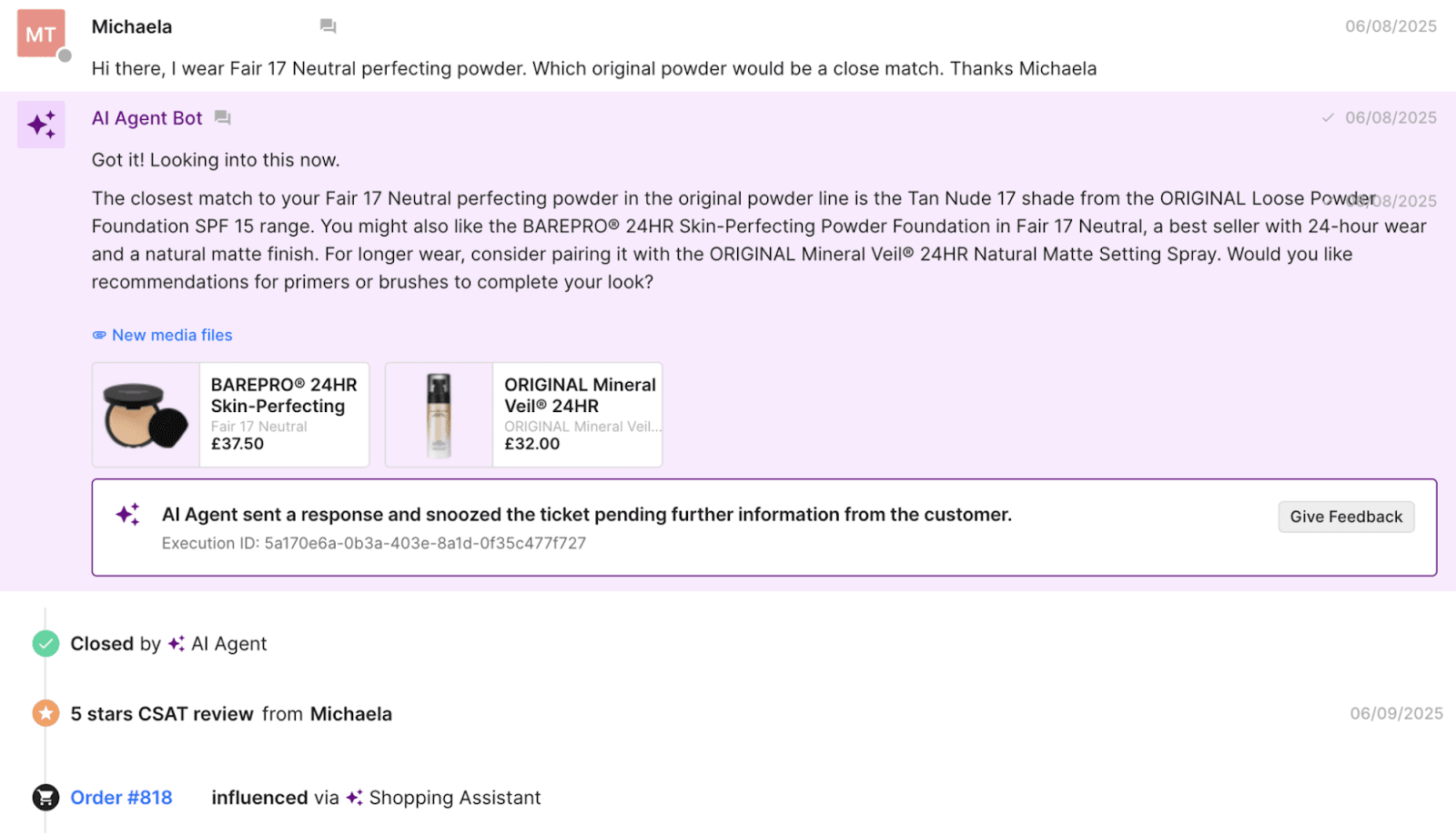
That accuracy paid off.
AI-influenced purchases at bareMinerals had zero returns in the first 30 days because customers were finally getting the right shade the first time.
That’s the difference between “resolved” and resolved well.
2. Zero-touch tickets: How many tickets never reach a human?
The zero-touch ticket rate measures something slightly different: the percentage of conversations AI manages entirely on its own, without ever being escalated to an agent.
This metric is a direct lens into:
- Workload reduction
- Team efficiency
- Cost savings
- AI’s ability to own high-volume question types
More importantly, deflection widens the funnel for more revenue-driven conversations.
When AI deflects more inbound questions, your support team can focus on conversations that truly require human expertise, including returns exceptions, escalations, VIP shoppers, and emotionally sensitive interactions.
Brands with strong deflection rates typically see:
- Shorter wait times
- Higher CSAT
- Lower support costs
- More AI-influenced revenue
Conversion and revenue impact metrics
If automation metrics tell you how well your AI is working, conversion and revenue metrics tell you how well it’s selling.
This category is where conversational commerce really proves its value because it shows the direct financial impact of every human- or AI-led interaction.
1. Chat Conversion Rate (CVR): How often do conversations turn into purchases?
Chat conversion rate measures the percentage of conversations that end in a purchase, and it’s one of the clearest indicators of whether your conversational strategy is influencing shopper decisions.
A strong CVR tells you that conversations are:
- Building confidence
- Removing hesitation
- Guiding shoppers toward the right product
You see this clearly with brands selling technical or performance-driven products.
Outdoor apparel shoppers, for example, don’t just need “a jacket” — they need to know which jacket will hold up in specific temperatures, conditions, or terrains. A well-trained AI can step into that moment and convert uncertainty into action.
Arc’teryx saw this firsthand.

Once Shopping Assistant started handling their high-intent pre-purchase questions, their chat conversion rate jumped dramatically — from 4% to 7%. A 75% lift.
That’s what happens when shoppers finally get the expert guidance they’ve been searching for.
2. GMV influenced: The revenue ripple effect of conversations
Not every shopper buys the moment they finish a chat. Some take a few hours. Some need a day or two. Some want to compare specs or read reviews before committing.
GMV influenced captures this “tail effect” by tracking revenue within 1–3 days of a conversation.
It’s especially powerful for:
- High-consideration purchases (like outdoor gear, home furniture, equipment)
- Products with many options, specs, or configurations
- Shoppers who need reassurance before buying
In Arc’teryx’s case, shoppers often take time to confirm they’re choosing the right technical gear.
Yet even with that natural pause in behavior, Shopping Assistant still influenced 3.7% of all revenue, not by forcing instant decisions, but by providing the clarity people needed to make the right one.
3. AOV from conversational commerce: Do conversations lead to bigger carts?
This metric looks at the average order value of shoppers who engage in a conversation versus those who don’t.
If the conversational AOV is higher, it means your AI or agents are educating customers in ways that naturally expand the cart.
Examples of AOV-lifting conversations include:
- Recommending complementary gear, tools, or accessories
- Suggesting upgraded options based on needs
- Helping shoppers understand the difference between product tiers
- Explaining why a specific product is worth the investment
When conversations are done well, AOV increases not because shoppers are being upsold, but because they’re being guided.
4. ROI of AI-powered conversations: The metric your leadership cares most about
ROI compares the revenue generated by conversational AI to the cost of the tool itself — in short, this is the number that turns heads in boardrooms.
Strong ROI shows that your AI:
- Does the work of multiple agents
- Drives new revenue, not just ticket deflection
- Provides accurate answers consistently, at any time
- Delivers a high-quality experience without expanding headcount
When ROI looks like that, AI stops being a “tool” and starts being an undeniable growth lever.
Related: The hidden power and ROI of automated customer support
Engagement metrics that indicate purchase intent
Not every metric in conversational commerce is a final outcome. Some are early signals that show whether shoppers are interested, paying attention, and moving closer to a purchase.
These engagement metrics are especially valuable because they reveal why conversations convert, not just whether they do. When engagement goes up, conversion usually follows.
1. Click-Through Rate (CTR): Are shoppers acting on the products your AI recommends?
CTR measures the percentage of shoppers who click the product links shared during a conversation. It’s one of the cleanest leading indicators of buyer intent because it reflects a moment where curiosity turns into action.
If CTR is high, it’s a sign that:
- Your recommendations are relevant
- The conversation is persuasive
- The shopper trusts the guidance they’re getting
- The AI is surfacing the right product at the right time
In other words, CTR tells you which conversations are influencing shopping behavior.
And the connection between CTR and revenue is often tighter than teams expect.
Just look at what happened with Caitlyn Minimalist. When they began comparing the results of human-led conversations versus AI-assisted ones over a 90-day period, CTR became one of the clearest predictors of success. Their Shopping Assistant consistently drove meaningful engagement with its recommendations — an 18% click-through rate on the products it suggested.
That level of engagement translated directly into better outcomes:
- AI-driven conversations converted at 20%, compared to just 8% for human agents
- Many of those clicks led to multi-item purchases
- Overall, the brand experienced a 50% lift in sales from AI-assisted chats compared to human-only ones
When shoppers click, they’re moving deeper into the buying cycle. Strong CTR makes it easier to forecast conversion and understand how well your conversational flows are guiding shoppers toward the right products.
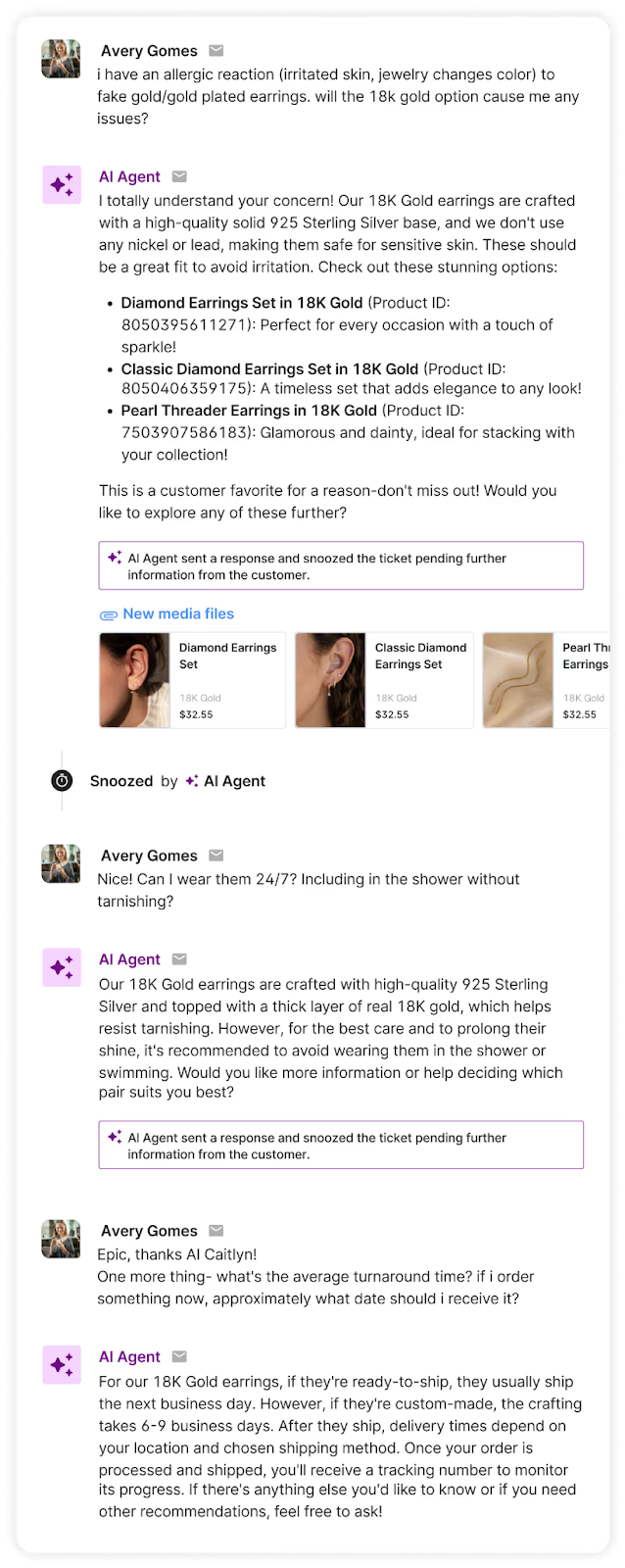
Discounting behavior metrics
Discounting can be one of the fastest ways to nudge a shopper toward checkout, but it’s also one of the fastest ways to erode margins.
That’s why discount-related metrics matter so much in conversational commerce.
They show not just whether AI is using discounts, but how effectively those discounts are driving conversions.
1. Discounts offered: Are incentives being used strategically or too often?
This metric tracks how many discount codes or promotional offers your AI is sharing during conversations.
Ideally, discounts should be purposeful — timed to moments when a shopper hesitates or needs an extra nudge — not rolled out as a one-size-fits-all script. When you monitor “discounts offered,” you can ensure that incentives are being used as conversion tools, not crutches.
This visibility becomes particularly important at high-intent touchpoints, such as exit intent or cart recovery interactions, where a small incentive can meaningfully increase conversion if used correctly.
2. Discounts applied: Are those discounts actually influencing the purchase?
Offering a discount is one thing. Seeing whether customers use it is another.
A high “discounts applied” rate suggests:
- The offer was compelling
- The timing was right
- The shopper truly needed that incentive to convert
A low usage rate tells a different story: Your team (or your AI) is discounting unnecessarily.
This metric alone often surprises brands. More often than not, CX teams discover they can discount less without hurting conversion, or that a non-discount incentive (like a relevant product recommendation) performs just as well.
Understanding this relationship helps teams tighten their promotional strategy, protect margins, and use discounts only where they actually drive incremental revenue.
How CX teams use these metrics to make better decisions
Once you know which metrics matter, the next step is building a system that brings them together in one place.
Think of your conversational commerce scorecard as a decision-making engine — something that helps you understand performance at a glance, spot bottlenecks, optimize AI, and guide shoppers more effectively.
In Gorgias, you can customize your analytics dashboard to watch the metrics that matter most to your brand. This becomes the single source of truth for understanding how conversations influence revenue.
Here’s what a powerful dashboard unlocks:
1. You learn where AI performs best (and where humans outperform)
Some parts of the customer journey are perfect for AI: repetitive questions, product education, sizing guidance, shade matching, order status checks.
Others still benefit from human support, like emotional conversations, complex troubleshooting, multi-item styling, or high-value VIP concerns.
Metrics like resolution rate, zero-touch ticket rate, and chat conversion rate show you exactly which is which.
When you track these consistently, you can:
- Identify conversation types AI should fully own
- Spot where AI needs more training
- Allocate human agents to higher-value conversations
- Decide when humans should step in to drive stronger outcomes
For example, if AI handles 80% of sizing questions successfully but struggles with multi-item styling advice, that tells you where to invest in improving AI, and where human expertise should remain the default.
2. You uncover what shoppers actually need to convert
Metrics like CTR, CVR, and conversational AOV reveal the inner workings of shopper decision-making. They show which recommendations resonate, which don’t, and which messaging actually moves someone to purchase.
With these insights, CX teams can:
- Refine product recommendations
- Improve conversation flows that stall out
- Adjust the tone or structure of AI messaging
- Draft stronger scripts for human agents
- Identify recurring questions that indicate missing PDP information
For instance, if shoppers repeatedly ask clarifying questions about a product’s material or fit, that’s a signal for merchandising or product teams.
If recommendations with social proof get high engagement, marketing can integrate that insight into on-site messaging.
Conversations reveal what customers really care about — often before analytics do.
3. You prove that conversations directly drive revenue
This is the moment when the scorecard stops being a CX tool and becomes a business tool.
A clear set of metrics shows how conversations tie to:
- GMV influenced
- AOV lift
- Revenue generated by AI
- ROI of conversational commerce tools
When a CX leader walks into a meeting and says, “Our AI Assistant influenced 5% of last month’s revenue” or “Conversational shoppers have a 20% higher AOV,” the perception of CX changes instantly.
You’re no longer a support cost. You’re a revenue channel.
And once you have numbers like ROI or revenue influence in hand, it becomes nearly impossible for anyone to argue against further investment in CX automation.
4. You identify where shoppers are dropping off or hesitating
A scorecard doesn’t just show what’s working, it surfaces what’s not.
Metrics make friction obvious:
Metric Signal |
What It Means |
|---|---|
Low CTR |
Recommendations may be irrelevant or poorly timed. |
Low CVR |
Conversations aren’t persuasive enough to drive a purchase. |
High deflection but low revenue |
AI is resolving tickets, but not effectively selling. |
High discount usage |
Shoppers rely on incentives to convert. |
Low discount usage |
You may be offering discounts unnecessarily and losing margin. |
Once you identify these patterns, you can run targeted experiments:
- Test new scripts or flows
- Adjust product recommendations
- Add social proof or benefit framing
- Reassess discounting strategies
- Rework messaging on key PDPs
Compounded over time, these moments create major lifts in conversion and revenue.
5. You create a feedback loop across marketing, merchandising, and product
One of the biggest hidden values of conversational data is how it strengthens cross-functional decision-making.
A clear analytics dashboard gives teams visibility into:
- Unclear or missing product information (from repeated questions)
- Merchandising opportunities (from your most popular products)
- Landing page or PDP improvements (from drop-off points)
- Messaging that resonates with real customers (from AI messages)
Suddenly, CX isn’t just answering questions — it’s informing strategy across the business.
CX drives revenue when you measure what matters
With the right metrics in place, CX leaders can finally quantify the impact of every interaction, and use that data to shape smarter, more profitable customer journeys.
If you're ready to measure — and scale — the impact of your conversations, tools like Gorgias AI Agent and Shopping Assistant give CX teams the visibility, accuracy, and performance needed to turn every interaction into revenue.
Want to see it in action? Book a demo and discover what conversational commerce can do for your bottom line.
{{lead-magnet-2}}
When Rhoback introduced an AI Agent to its customer experience team, it did more than automate routine tickets. Implementation revealed an opportunity to improve documentation, collaborate cross-functionally, and establish a clear brand tone of voice.
Samantha Gagliardi, Associate Director of Customer Experience at Rhoback, explains the entire process in the first episode of our AI in CX webinar series.
Key takeaways:
- Implement quickly and iterate. Rhoback’s initial rollout process took two weeks, right before BFCM. Samantha moved quickly, starting with basic FAQs and then continuously optimizing.
- Train AI like a three-year-old. Although it is empathetic, an AI Agent does not inherently know what is right or wrong. Invest in writing clear Guidance, testing responses, and ensuring document accuracy.
- Approach your AI’s tone of voice like a character study. Your AI Agent is an extension of your brand, and its personality should reflect that. Rhoback conducted a complete analysis of its agent’s tone, age, energy, and vocabulary.
- Embrace AI as a tool to reveal inconsistencies. If your AI Agent is giving inaccurate information, it’s exposing gaps in your knowledge sources. Uses these early test responses to audit product pages, help center content, Guidance, and policies.
- Check in regularly and keep humans in control. Introduce weekly reviews or QA rituals to refine AI’s accuracy, tone, and efficiency. Communicate AI insights cross-functionally to build trust and work towards shared goals.
Top learnings from Rhoback’s AI rollout
1. You can start before you “feel ready”
With any new tool, the pre-implementation phase can take some time. Creating proper documentation, training internal teams, and integrating with your tech stack are all important steps that happen before you go live.
But sometimes it’s okay just to launch a tool and optimize as you go.
Rhoback launched its AI agent two weeks before BFCM to automate routine tickets during the busy season.
Why it worked:
- Samantha had audited all of Rhoback’s SOPs, training materials, and FAQs a few months before implementation.
- They started by automating high-volume questions such as returns, exchanges, and order tracking.
- They followed a structured AI implementation checklist.
2. Audit your knowledge sources before you automate
Before turning on Rhoback’s AI Agent, Samantha’s team reviewed every FAQ, policy, and help article that human agents are trained on. This helped establish clear CX expectations that they could program into an AI Agent.
Samantha also reviewed the most frequently asked questions and the ideal responses to each. Which ones needed an empathetic human touch and which ones required fast, accurate information?
“AI tells you immediately when your data isn’t clean. If a product detail page says one thing and the help center says another, it shows up right away.”
Rhoback’s pre-implementation audit checklist:
- Review customer FAQs and the appropriate responses for each.
- Update outdated PDPs, Help Centre articles, policies, and other relevant documentation.
- Establish workflows with Ecommerce and Product teams to align Macros, Guidance, and Help Center articles with product descriptions and website copy.
Read more: How to Optimize Your Help Center for AI Agent
3. Train your AI Agent in small, clear steps
It’s often said that you should train your AI Agent like a brand-new employee.
Samantha took it one step further and recommended treating AI like a toddler, with clear, patient, repetitive instructions.
“The AI does not have a sense of good and bad. It’s going to say whatever you train it, so you need to break it down like you’re talking to a three-year-old that doesn’t know any different. Your directions should be so detailed that there is no room for error.”
Practical tips:
- Use AI to build your AI Guidance, focusing on clear, detailed, simple instructions.
- Test each Guidance before adding new ones.
- Treat the training process like an ongoing feedback loop, not a one-time upload.
Read more: How to Write Guidance with the “When, If, Then” Framework
4. Prioritize Tone of Voice to make AI feel natural
For Rhoback, an on-brand Tone of Voice was a non-negotiable. Samantha built a character study that shaped Rhoback’s AI Agent’s custom brand voice.
“I built out the character of Rhoback, how it talks, what age it feels like, what its personality is. If it does not sound like us, it is not worth implementing.”
Key questions to shape your AI Agent’s tone of voice:
- How does the AI Agent speak? Friendly, funny, empathetic, etc…?
- Does your AI Agent use emojis? How often?
- Are there any terms or phrases the AI Agent should always or never say?
5. Use AI to surface knowledge gaps or inconsistencies
Once Samantha started testing the AI Agent, it quickly revealed misalignment between Rhoback’s teams. With such an extensive product catalog, AI showed that product details did not always match the Help Center or CX documentation.
This made a case for stronger collaboration amongst the CX, Product, and Ecommerce teams to work towards their shared goal of prioritizing the customer.
“It opened up conversations we were not having before. We all want the customer to be happy, from the moment they click on an ad to the moment they purchase to the moment they receive their order. AI Agent allowed us to see the areas we need to improve upon.”
Tips to improve internal alignment:
- Create regular syncs between CX, Product, Ecommerce, and Marketing teams.
- Share AI summaries, QA insights, and trends to highlight recurring customer pain points.
- Build a collaborative workflow for updating documents that gives each team visibility.
6. Build trust (with your team and customers) through transparency
Despite the benefits of AI for CX, there’s still trepidation. Agents are concerned that AI would replace them, while customers worry they won’t be able to reach a human. Both are valid concerns, but clearly communicating internally and externally can mitigate skepticism.
At Rhoback, Samantha built internal trust by looping in key stakeholders throughout the testing process. “I showed my team that it is not replacing them. It’s meant to be a support that helps them be even more successful with what they’re already doing," Samantha explains.
On the customer side, Samantha trained their AI Agent to tell customers in the first message that it is an AI customer service assistant that will try to help them or pass them along to a human if it can’t.
How Rhoback built AI confidence:
- Positioned AI as a personal assistant for agents, not a replacement.
- Let agents, other departments, and leadership test and shape the AI Agent experience early.
- Told customers up front when automation was being used and made the path to a human clear and easy.
Read more: How CX Leaders are Actually Using AI: 6 Must-Know Lessons
Putting these into practice: Rhoback’s framework for an aligned AI implementation
Here is Rhoback’s approach distilled into a simple framework you can apply.
- Audit your content: Ensure your FAQs, product data, policies, and all documentation are accurate.
- Start small: Automate one repetitive workflow, such as returns or tracking.
- Train iteratively: Add Guidance in small, testable batches.
- Prioritize tone: Make sure every AI reply sounds like your brand.
- Align teams: Use AI data to resolve cross-departmental inconsistencies and establish clearer communication lines.
- Be transparent: Tell both agents and customers how AI fits into the process.
- Refine regularly: Review, measure, and adjust on an ongoing basis.
Watch the full conversation with Samantha to learn how AI can act as a catalyst for better internal alignment.
📌 Join us for episode 2 of AI in CX: Building a Conversational Commerce Strategy that Converts with Cornbread Hemp on December 16.
{{lead-magnet-1}}
Newsletter Signup
The best in CX and ecommerce, right to your inbox
Featured articles
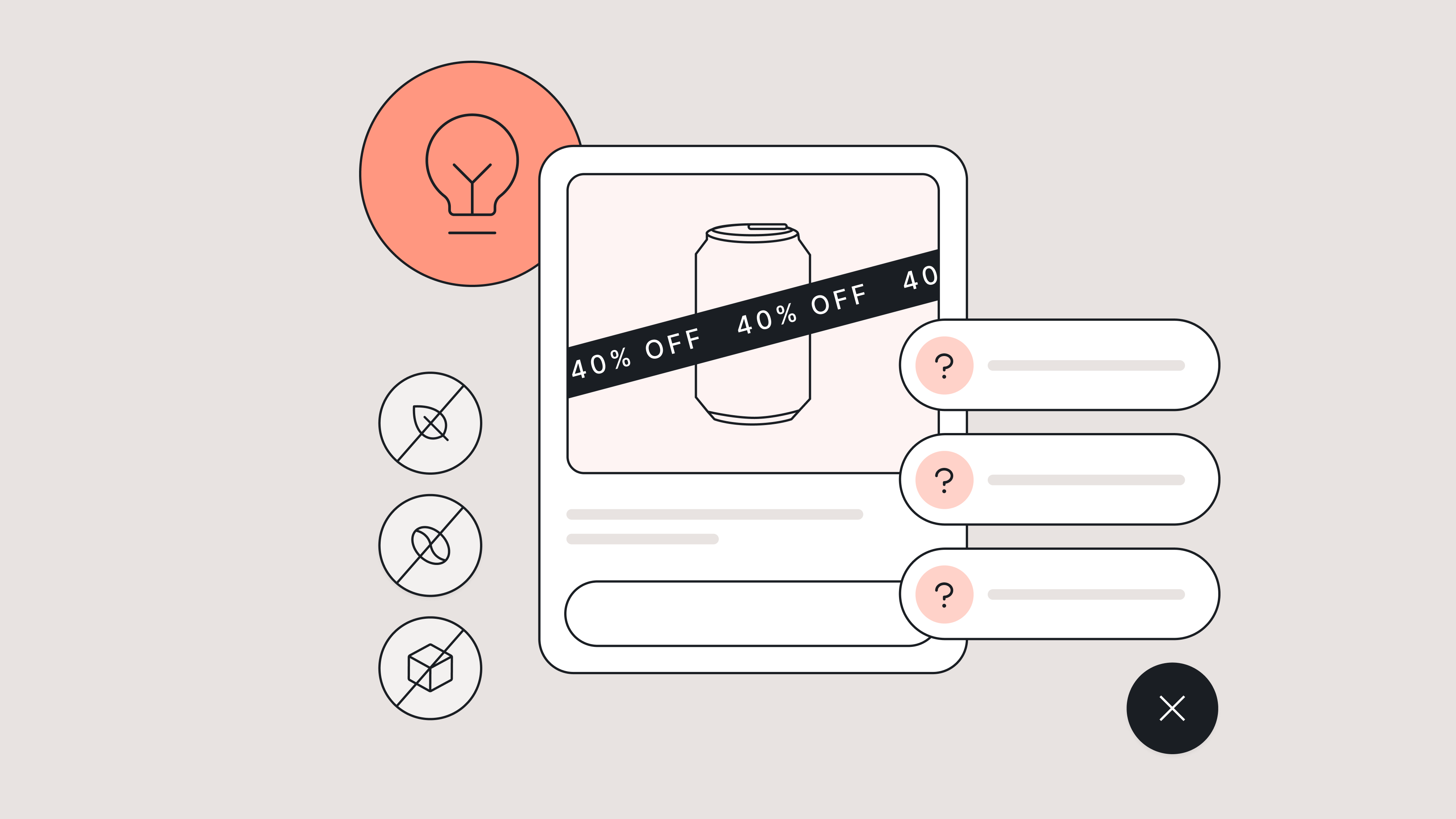
How Food & Beverage Brands Can Level Up Self-Service Before BFCM
TL;DR:
- Most food & beverage support tickets during BFCM are predictable. Subscription cancellations, WISMO, and product questions make up the bulk—so prep answers ahead of time.
- Proactive CX site updates can drastically cut down repetitive tickets. Add ingredient lists, cooking instructions, and clear refund policies to product pages and FAQs.
- FAQ pages should go deep, not just broad. Answer hyper-specific questions like “Will this break my fast?” to help customers self-serve without hesitation.
- Transparency about stock reduces confusion and cart abandonment. Show inventory levels, set up waitlists, and clearly state cancellation windows.
In 2024, Shopify merchants drove $11.5 billion in sales over Black Friday Cyber Monday. Now, BFCM is quickly approaching, with some brands and major retailers already hosting sales.
If you’re feeling late to prepare for the season or want to maximize the number of sales you’ll make, we’ll cover how food and beverage CX teams can serve up better self-serve resources for this year’s BFCM.
Learn how to answer and deflect customers’ top questions before they’re escalated to your support team.
💡 Your guide to everything peak season → The Gorgias BFCM Hub
Handling BFCM as a food & beverage brand
During busy seasons like BFCM and beyond, staying on top of routine customer asks can be an extreme challenge.
“Every founder thinks BFCM is the highest peak feeling of nervousness,” says Ron Shah, CEO and Co-founder of supplement brand Obvi.
“It’s a tough week. So anything that makes our team’s life easier instantly means we can focus more on things that need the time,” he continues.
Anticipating contact reasons and preparing methods (like automated responses, macros, and enabling an AI Agent) is something that can help. Below, find the top contact reasons for food and beverage companies in 2025.
Top contact reasons in the food & beverage industry
According to Gorgias proprietary data, the top reason customers reach out to brands in the food and beverage industry is to cancel a subscription (13%) followed by order status questions (9.1%).
Contact Reason |
% of Tickets |
|---|---|
🍽️ Subscription cancellation |
13% |
🚚 Order status (WISMO) |
9.1% |
❌ Order cancellation |
6.5% |
🥫 Product details |
5.7% |
🧃 Product availability |
4.1% |
⭐ Positive feedback |
3.9% |
7 ways to improve your self-serve resources before BFCM
- Add informative blurbs on product pages
- Craft additional help center and FAQ articles
- Automate responses with AI or Macros
- Get specific about product availability
- Provide order cancellation and refund policies upfront
- Add how-to information
- Build resources to help with buying decisions
1) Add informative blurbs on product pages
Because product detail queries represent 5.7% of contact reasons for the food and beverage industry, the more information you provide on your product pages, the better.
Include things like calorie content, nutritional information, and all ingredients.
For example, ready-to-heat meal company The Dinner Ladies includes a dropdown menu on each product page for further reading. Categories include serving instructions, a full ingredient list, allergens, nutritional information, and even a handy “size guide” that shows how many people the meal serves.

2) Craft additional Help Center and FAQ articles
FAQ pages make up the information hub of your website. They exist to provide customers with a way to get their questions answered without reaching out to you.
This includes information like how food should be stored, how long its shelf life is, delivery range, and serving instructions. FAQs can even direct customers toward finding out where their order is and what its status is.

In the context of BFCM, FAQs are all about deflecting repetitive questions away from your team and assisting shoppers in finding what they need faster.
That’s the strategy for German supplement brand mybacs.
“Our focus is to improve automations to make it easier for customers to self-handle their requests. This goes hand in hand with making our FAQs more comprehensive to give customers all the information they need,” says Alexander Grassmann, its Co-Founder & COO.
As you contemplate what to add to your FAQ page, remember that more information is usually better. That’s the approach Everyday Dose takes, answering even hyper-specific questions like, “Will it break my fast?” or “Do I have to use milk?”
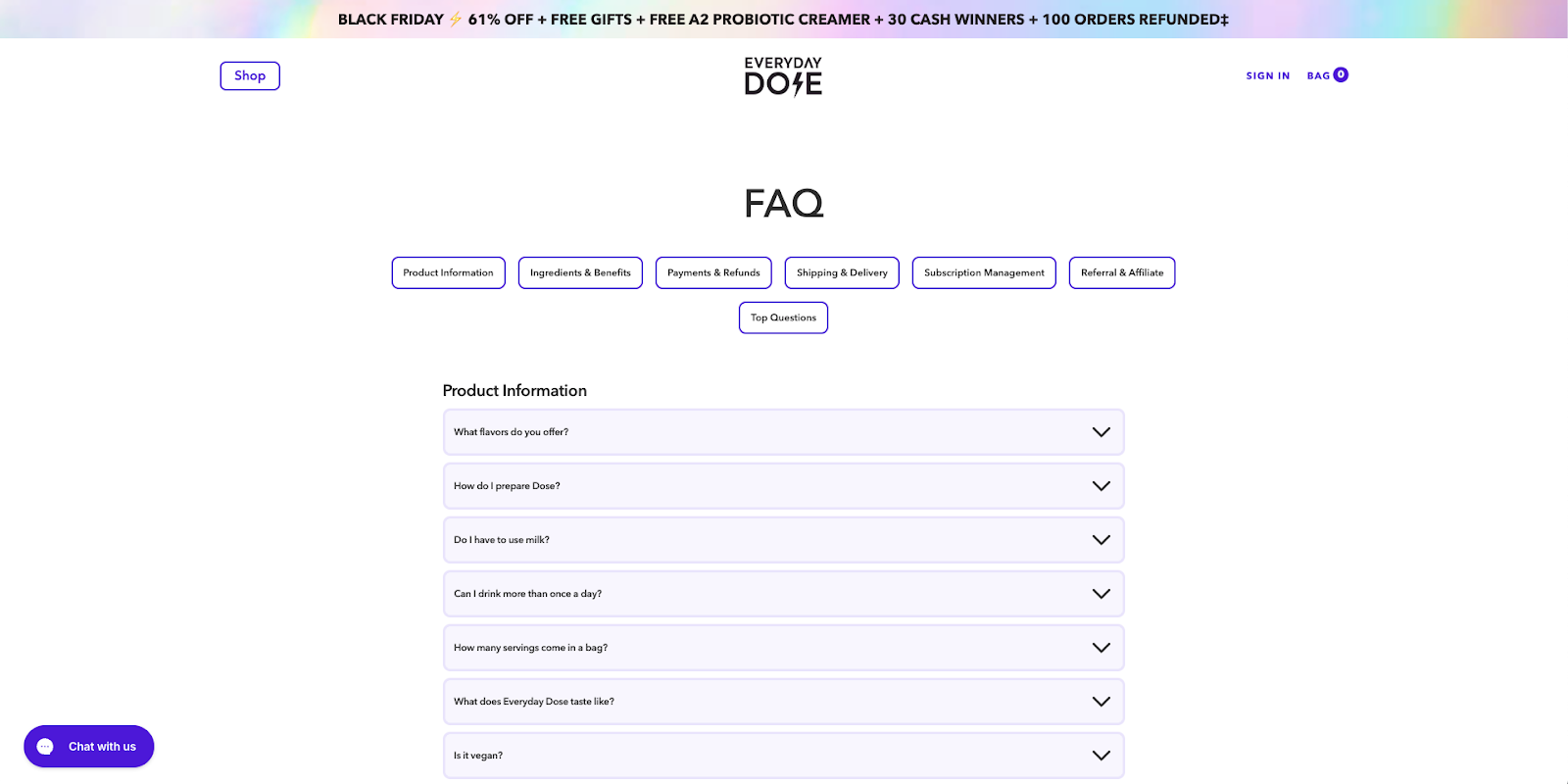
While the FAQs you choose to add will be specific to your products, peruse the top-notch food and bev FAQ pages below.
Time for some FAQ inspo:
- Juice Plus+ FAQ
- Everyday Dose FAQ
- Chamberlain Coffee FAQ
- Jurassic Fruit FAQ
- Rebel Cheese FAQ
- The Dinner Ladies FAQ
3) Automate responses with AI or macros
AI Agents and AI-powered Shopping Assistants are easy to set up and are extremely effective in handling customer interactions––especially during BFCM.
“I told our team we were going to onboard Gorgias AI Agent for BFCM, so a good portion of tickets would be handled automatically,” says Ron Shah, CEO and Co-founder at Obvi. “There was a huge sigh of relief knowing that customers were going to be taken care of.”
And, they’re getting smarter. AI Agent’s CSAT is just 0.6 points shy of human agents’ average CSAT score.
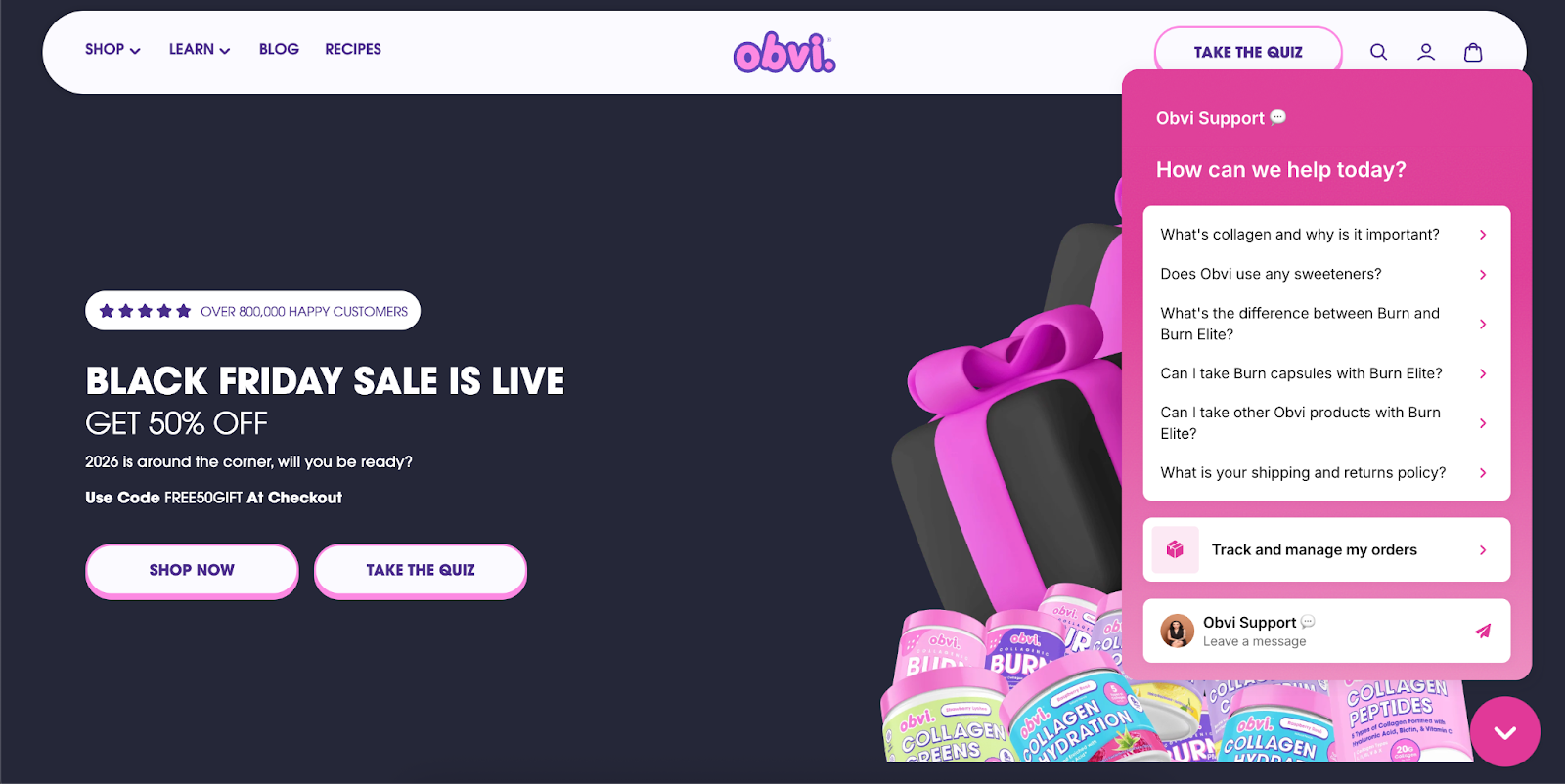
Here are the specific responses and use cases we recommend automating:
- WISMO (where is my order) inquiries
- Product related questions
- Returns
- Order issues
- Cancellations
- Discounts, including BFCM related
- Customer feedback
- Account management
- Collaboration requests
- Rerouting complex queries
Get your checklist here: How to prep for peak season: BFCM automation checklist
4) Get specific about product availability
With high price reductions often comes faster-than-usual sell out times. By offering transparency around item quantities, you can avoid frustrated or upset customers.
For example, you could show how many items are left under a certain threshold (e.g. “Only 10 items left”), or, like Rebel Cheese does, mention whether items have sold out in the past.

You could also set up presales, give people the option to add themselves to a waitlist, and provide early access to VIP shoppers.
5) Provide order cancellation and refund policies upfront
Give shoppers a heads up whether they’ll be able to cancel an order once placed, and what your refund policies are.
For example, cookware brand Misen follows its order confirmation email with a “change or cancel within one hour” email that provides a handy link to do so.
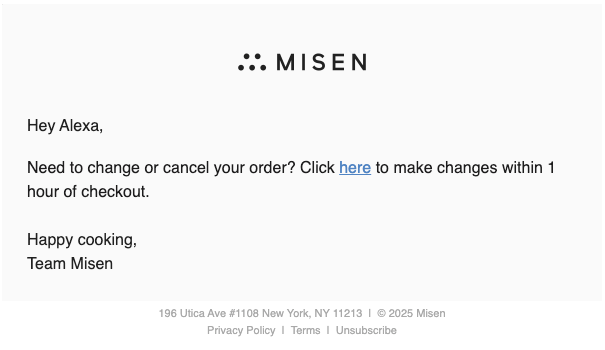
Your refund policies and order cancellations should live within an FAQ and in the footer of your website.
6) Add how-to information
Include how-to information on your website within your FAQs, on your blog, or as a standalone webpage. That might be sharing how to use a product, how to cook with it, or how to prepare it. This can prevent customers from asking questions like, “how do you use this?” or “how do I cook this?” or “what can I use this with?” etc.
For example, Purity Coffee created a full brewing guide with illustrations:
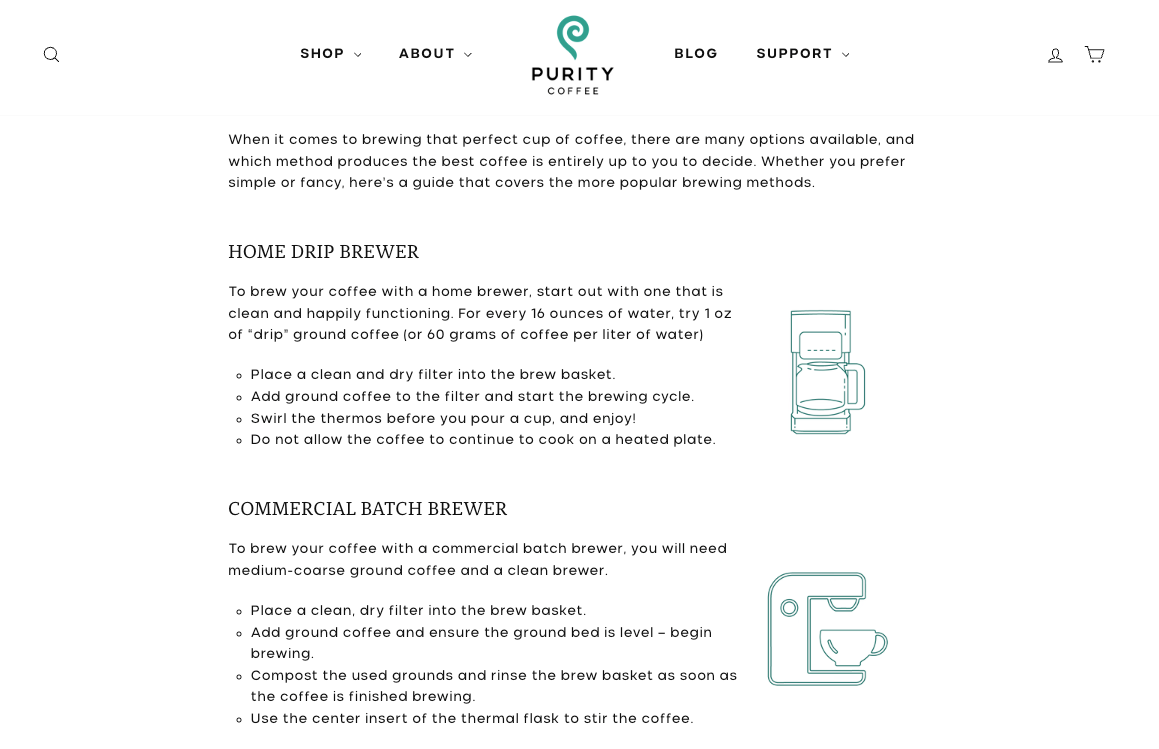
Similarly, for its unique preseasoned carbon steel pan, Misen lists out care instructions:

And for those who want to understand the level of prep and cooking time involved, The Dinner Ladies feature cooking instructions on each product page.

7) Build resources to help with buying decisions
Interactive quizzes, buying guides, and gift guides can help ensure shoppers choose the right items for them––without contacting you first.
For example, Trade Coffee Co created a quiz to help first timers find their perfect coffee match:
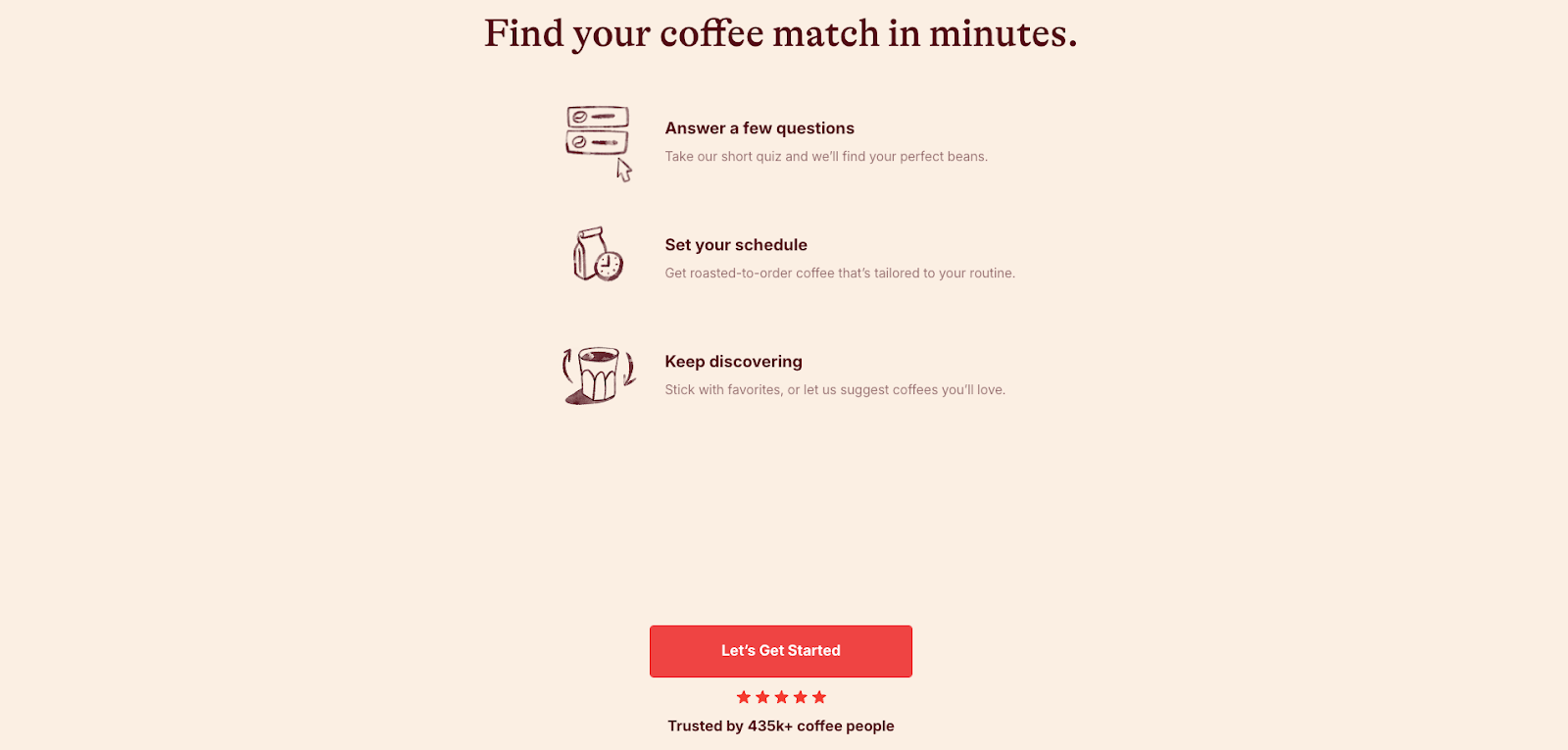
Set your team up for BFCM success with Gorgias
The more information you can share with customers upfront, the better. That will leave your team time to tackle the heady stuff.
If you’re looking for an AI-assist this season, check out Gorgias’s suite of products like AI Agent and Shopping Assistant.
{{lead-magnet-2}}

What is Conversational AI? The Ecommerce Guide
TL;DR:
- Conversational AI combines natural language processing, machine learning, and generative AI to create human-like interactions
- For ecommerce, it automates customer service, drives sales through personalized recommendations, and scales support 24/7
- Key types include chatbots, voice assistants, and AI agents that handle both support and sales tasks
- Implementation requires defining clear goals, choosing an ecommerce-ready platform, and connecting your tech stack
Conversational AI changes how ecommerce brands interact with customers by enabling natural, human-like conversations at scale, helping reduce customer churn.
Instead of forcing shoppers through rigid menus or making them wait for support, conversational AI understands questions, detects intent, and delivers instant, personalized responses.
This technology powers everything from customer service chatbots to voice assistants, helping brands automate repetitive tasks while maintaining the personal touch customers expect.
For ecommerce specifically, it means handling order inquiries, providing product recommendations, and recovering abandoned carts — all without adding headcount.
What is conversational AI?
Conversational AI is a type of artificial intelligence that allows computers to understand, process, and respond to human language through natural, two-way conversations. This means your customers can ask questions in their own words and get helpful answers that feel like they're talking to a real person.
Unlike basic chatbots that only recognize specific keywords, conversational AI actually understands what your customers mean. It can handle typos, slang, and complex questions that have multiple parts. The AI learns from every conversation, getting better at helping your customers over time.
Think of it as having a super-smart team member who never sleeps, never gets frustrated, and remembers every detail about your products and policies. This AI team member can chat with customers on your website, answer questions through social media, or even handle phone calls.
What are the key components of conversational AI?
Conversational AI works because several smart technologies team up to understand and respond to your customers. Each piece has a specific job in making conversations feel natural and helpful.
Natural Language Processing (NLP) is the foundation that breaks down human language into pieces a computer can understand. This means when a customer types "Where's my order?" the AI can identify the important words and grammar structure.
Natural Language Understanding (NLU) figures out what the customer actually wants. This is the smart part that realizes "Where's my order?" means the customer wants to track a shipment, even if they phrase it differently like "I need to check my package status."
Natural Language Generation (NLG) creates responses that sound human and helpful. Instead of robotic answers, it crafts replies that match your brand's voice and provide exactly what the customer needs to know.
The dialog manager keeps track of the entire conversation. This means if a customer asks a follow-up question, the AI remembers what you were just talking about and can give a relevant answer.
Your knowledge base stores all the information the AI needs to help customers. This includes your return policy, product details, shipping information, and any other facts your team would use to answer questions.
How does conversational AI work?
Conversational AI follows a simple three-step process that happens in seconds. Understanding this process helps you see why it's so much more powerful than old-school chatbots.
1) It processes input across voice and text with NLP
When a customer sends a message or asks a question, the AI first needs to understand what they're saying. For text messages from chat, email, or social media, the system breaks down the sentence into individual words and analyzes the grammar.
For voice interactions like phone calls, the AI uses speech recognition to turn spoken words into text first. Modern systems handle different accents, background noise, and natural speech patterns without missing a beat.
2) It detects intent and context with NLU
Once the AI has the customer's words, it needs to figure out what they actually want. The system looks for the customer's intent — their goal or what they're trying to accomplish.
For example, when someone asks "Can I return this sweater I bought last week?" the AI identifies the intent as wanting to make a return. It also pulls out important details like the product type and timeframe.
The AI also uses context from earlier in the conversation. If the customer mentioned their order number earlier, the AI remembers it and can use that information to help with the return request.
3) It generates responses with NLG
After understanding what the customer wants, the AI creates a helpful response. It might pull information from your knowledge base, personalize the answer with the customer's specific details, or generate a completely new response using generative AI.
The system also checks how confident it is in its answer. If the AI isn't sure about something or if the topic is too complex, it knows to hand the conversation over to one of your human agents.
What are the types of conversational AI?
Different types of conversational AI work better for different situations in your ecommerce business. Understanding these types helps you choose the right solution for your customers and team.
Chatbots handle scripted and AI-driven chat
Chatbots are the most common type you'll see on websites and messaging apps. Early chatbots followed strict scripts — if a customer's question didn't match the script exactly, the bot would get confused and give unhelpful answers.
Modern AI-powered chatbots understand natural language and can handle much more complex conversations. The best systems combine both approaches: using simple rules for straightforward questions and AI for everything else.
These chatbots work great for answering common questions about shipping, returns, and product details. They can also help customers find the right products or guide them through your checkout process.
Voice assistants manage speech-based requests
Voice assistants bring conversational AI to phone support and other voice channels. These aren't the old phone trees that made customers press numbers to navigate menus.
Instead, customers can speak naturally and get helpful answers right away. Voice assistants can look up order information, explain your return policy, or even process simple requests like address changes.
This works especially well for customers who prefer calling over typing, or when they need help while their hands are busy.
Read more: How Cornbread Hemp reached a 13.6% phone conversion rate with Gorgias Voice
AI agents and copilots assist teams and customers
AI agents are the most advanced type of conversational AI. Unlike chatbots that mainly provide information, AI agents can actually take action on behalf of customers.
These systems connect to your other business tools like Shopify, your shipping software, or your returns platform. This means they can do things like:
- Process returns: Start a return and send the customer a shipping label
- Update orders: Change a shipping address or add items to an existing order
- Handle refunds: Issue refunds for eligible orders automatically
- Manage subscriptions: Skip shipments or update subscription preferences
Copilots work alongside your human agents, suggesting responses and pulling up customer information to help resolve issues faster.
Read more: How AI Agent works & gathers data
What are the benefits of conversational AI for ecommerce?
Conversational AI delivers real business results for ecommerce brands. The benefits go beyond just making your support team more efficient — though that's certainly part of it.
24/7 availability means you never miss a sale or support opportunity. Customers can get help at 2 a.m. or during holidays when your team is offline. This is especially valuable for international customers in different time zones.
Instant responses prevent cart abandonment and customer frustration, improving first contact resolution. When someone has a question about sizing or shipping, they get an answer immediately instead of waiting hours or days for an email response.
Personalized interactions at scale drive higher average order values. The AI can recommend products based on what customers are browsing, their purchase history, and their preferences, just like your best salesperson would.
Cost efficiency comes from handling repetitive questions automatically. Your human agents can focus on complex issues, VIP customers, and revenue-generating activities instead of answering the same shipping questions over and over.
Multilingual support helps you serve global customers without hiring native speakers for every language. The AI can communicate in dozens of languages, opening up new markets for your business.
What are the most valuable conversational AI use cases for ecommerce?
Certain moments in the shopping experience create the biggest opportunities for conversational AI to drive results. Focus on these high-impact use cases first.
Pre-purchase questions are your biggest conversion opportunity. When someone is looking at a product but hasn't bought yet, quick answers about sizing, materials, or compatibility can close the sale. The AI can also suggest complementary products or highlight features the customer might have missed.
Order tracking makes up the largest volume of support tickets for most ecommerce brands. Customers want to know where their package is, when it will arrive, and what to do if there's a delay. AI handles these WISMO requests instantly by pulling real-time tracking information.
Returns and exchanges can be complex, but AI excels at the initial screening. It can check if an item is eligible for return, explain your policy, and start the return process. For straightforward returns, customers never need to wait for human help.
Cart recovery works best when it's immediate and personal. AI can detect when someone abandons their cart and reach out through chat or email with personalized messages, discount offers, or answers to common concerns that prevent purchases.
Post-purchase support keeps customers happy after they buy. The AI can send order confirmations, provide care instructions, suggest related products, and handle simple issues like address changes.
How do you implement conversational AI in an ecommerce tech stack?
Getting started with conversational AI doesn't require a complete overhaul of your systems. The key is starting with clear goals and building your capabilities over time.
Step 1: Define goals and KPIs for automation
The best automation opportunities are found in your tickets. Look for questions that come up repeatedly and have straightforward answers. Common examples include order status, return policies, and basic product information.
Set realistic goals for your first phase. You might aim to automate 30% of your tickets or reduce average response time by half. Track metrics like:
- Automation rate: Percentage of tickets resolved without human intervention
- Customer satisfaction: How happy customers are with AI interactions
- Revenue impact: Sales influenced by AI recommendations or cart recovery
Step 2: Choose an ecommerce-ready AI platform
Not all conversational AI platforms understand ecommerce needs. Look for a platform that integrates directly with Shopify and your other business tools. This connection is essential for pulling real-time order data, customer history, and product information.
Your platform should come with pre-built actions for common ecommerce tasks like order lookups, return processing, and subscription management. This saves months of custom development work.
Make sure you can control the AI's behavior through clear guidance and rules. You need to be able to set your brand voice, define when to escalate to humans, and update the AI's knowledge as your business changes.
Step 3: Connect Shopify and key tools, then iterate
Start your implementation by connecting your Shopify store to give the AI access to order and customer data. Don’t forget to integrate the rest of your tech stack like shipping software, returns platforms, and loyalty programs.
Launch with a few core use cases like order tracking and basic product questions. Monitor the AI's performance closely and gather feedback from both customers and your support team. Use this data to refine the AI's responses and gradually expand its capabilities.
The best approach is iterative — start small, learn what works, and build from there.
What are the challenges and risks of conversational AI?
While conversational AI offers significant benefits, you need to be aware of potential challenges and plan for them from the start.
Accuracy concerns arise when AI systems provide incorrect information or "hallucinate" facts that aren't true. Prevent this by using platforms that ground responses in your verified knowledge base and product data rather than generating answers from scratch.
Brand voice consistency becomes critical when AI represents your brand to customers. Set clear guidelines for tone, style, and messaging. Test the AI's responses regularly to ensure they align with how your human team would handle similar situations.
Data privacy requires careful attention since conversational AI handles sensitive customer information. Choose platforms with strong security measures, data encryption, and compliance with regulations like GDPR. Look for features like automatic removal of personal information from conversation logs.
Over-automation can frustrate customers when complex issues require human empathy and problem-solving. Design clear escalation paths so customers can easily reach human agents when needed. Train your AI to recognize when a situation is beyond its capabilities.
Integration complexity can slow down implementation if your chosen platform doesn't work well with your existing tools. This is why choosing an ecommerce-focused platform with pre-built integrations is so important.
Turn conversations into revenue with conversational AI
The brands winning with conversational AI start with clear goals, choose the right platform, and iterate based on real performance data. They don't try to automate everything at once. They focus on high-impact use cases that deliver real results.
Ready to see how conversational AI can transform your ecommerce support and sales? Book a demo with Gorgias — built specifically for ecommerce brands.
{{lead-magnet-2}}
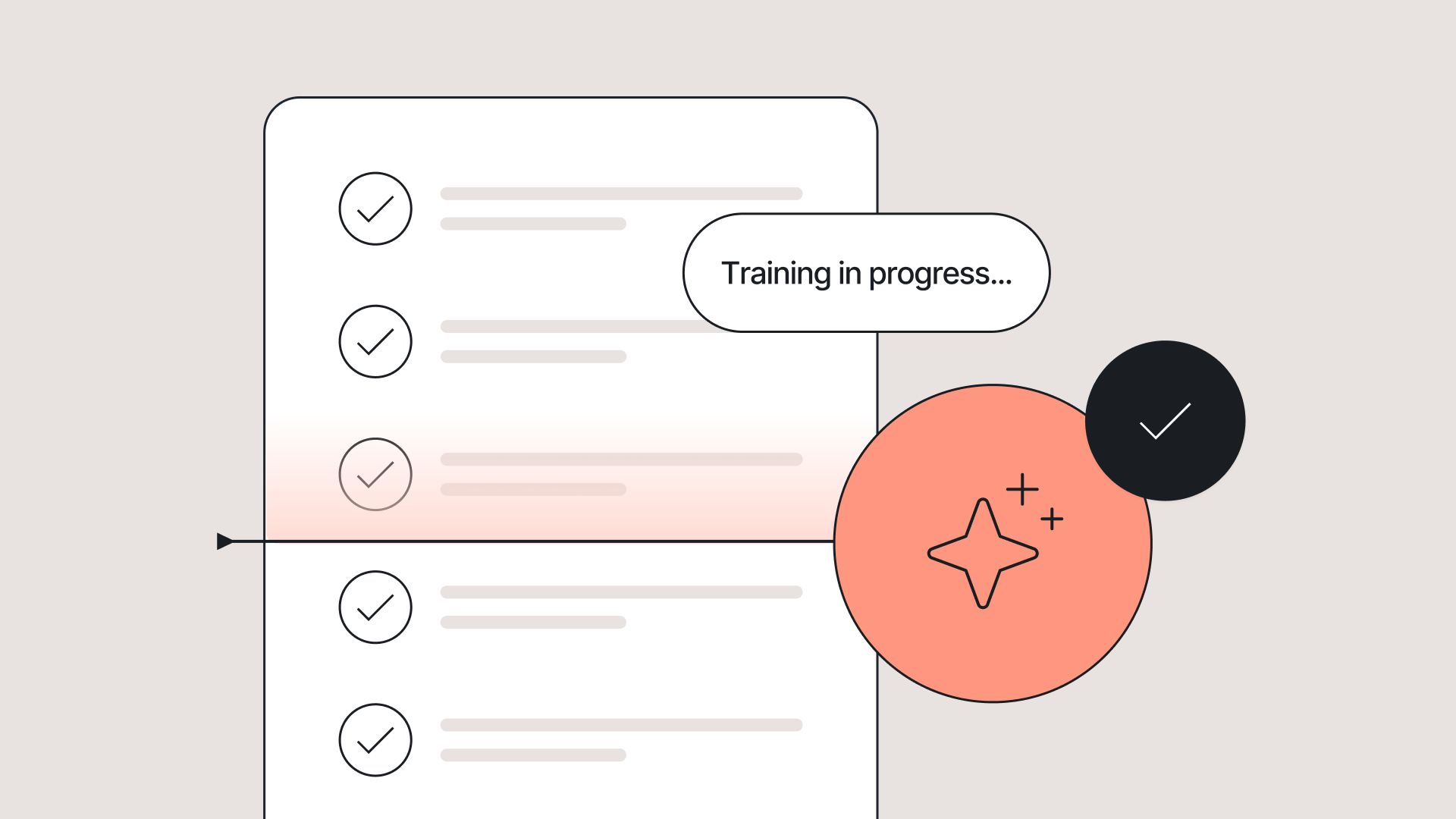
How to Make Your Help Center LLM-Friendly
TL;DR:
- You don’t need to rebuild your Help Center to make it work with AI—you just need to structure it smarter.
- AI Agent reads your content in three layers: Help Center, Guidance, and Actions, following an “if / when / then” logic to find and share accurate answers.
- Most AI escalations happen because Help Docs are vague or incomplete. Start by improving your top 10 ticket topics—like order status, returns, and refunds.
- Make your articles scannable, define clear conditions, link next steps, and keep your tone consistent. These small tweaks help AI Agent resolve more tickets on its own—and free up your team to focus on what matters most.
As holiday season support volumes spike and teams lean on AI to keep up, one frustration keeps surfacing, our Help Center has the answers—so why can’t AI find them?
The truth is, AI can’t help customers if it can’t understand your Help Center. Most large language models (LLMs), including Gorgias AI Agent, don’t ignore your existing docs, they just struggle to find clear, structured answers inside them.
The good news is you don’t need to rebuild your Help Center or overhaul your content. You simply need to format it in a way that’s easy for both people and AI to read.
We’ll break down how AI Agent reads your Help Center, finds answers, and why small formatting changes can help it respond faster and more accurately, so your team spends less time on escalations.
{{lead-magnet-1}}
How AI Agent uses your Help Center content
Before you start rewriting your Help Center, it helps to understand how AI Agent actually reads and uses it.
Think of it like a three-step process that mirrors how a trained support rep thinks through a ticket.
1. Read Help Center docs
Your Help Center is AI Agent’s brain. AI Agent uses your Help Center to pull facts, policies, and instructions it needs to respond to customers accurately. If your articles are clearly structured and easy to scan, AI Agent can find what it needs fast. If not, it hesitates or escalates.
2. Follow Guidance instructions
Think of Guidance as AI Agent’s decision layer. What should AI Agent do when someone asks for a refund? What about when they ask for a discount? Guidance helps AI Agent provide accurate answers or hand over to a human by following an “if/when/then” framework.
3. Respond and perform
Finally, AI Agent uses a combination of your help docs and Guidance to respond to customers, and if enabled, perform an Action on their behalf—whether that’s changing a shipping address or canceling an order altogether.
Here’s what that looks like in practice:
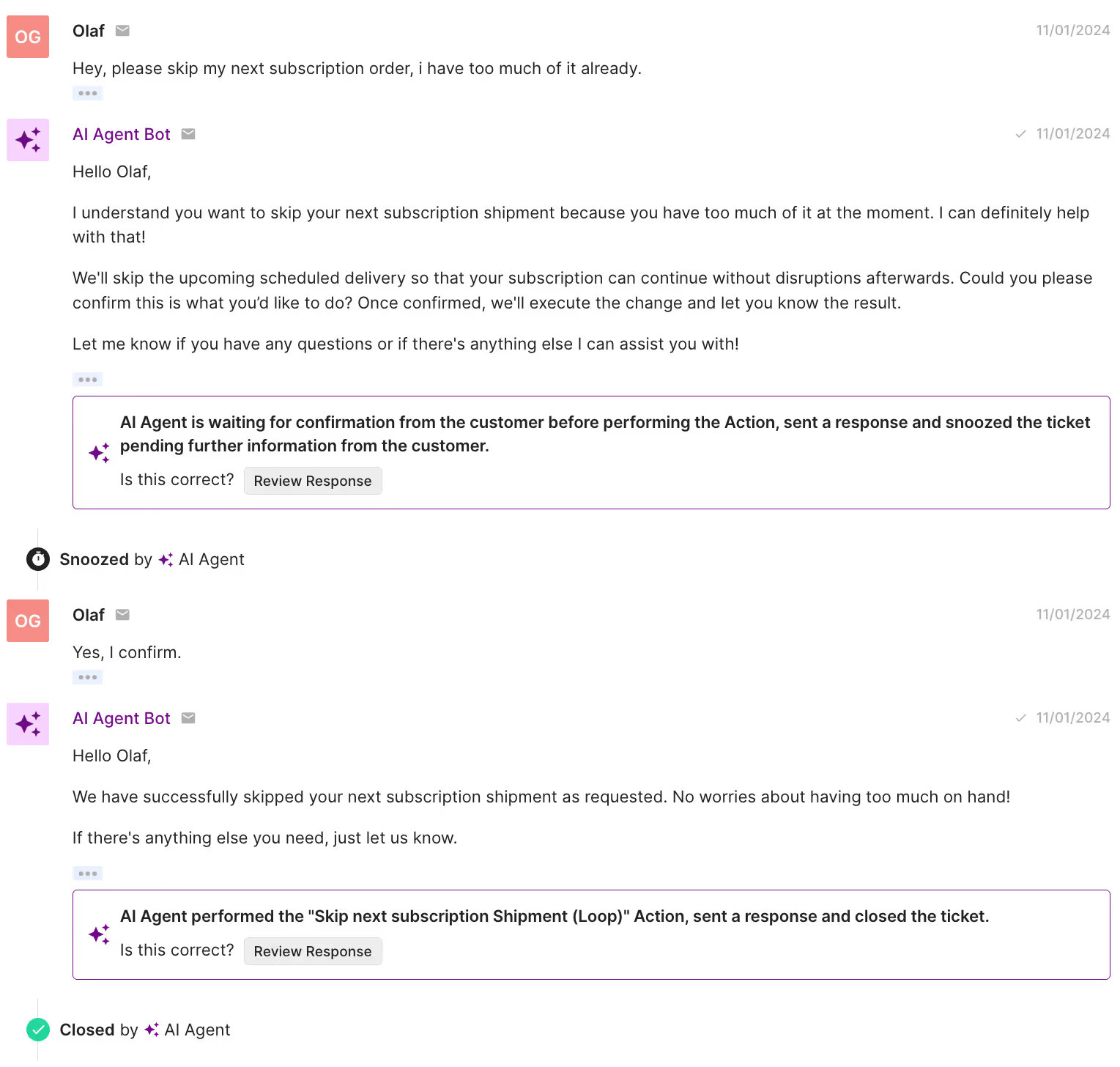
This structure removes guesswork for both your AI and your customers. The clearer your docs are about when something applies and what happens next, the more accurate and human your automated responses will feel.
A Help Center written for both people and AI Agent:
- Saves your team time
- Reduces escalations
- Helps every customer get the right answer the first time
What causes AI Agent to escalate tickets, and how to fix it
Our data shows that most AI escalations happen for a simple reason––your Help Center doesn’t clearly answer the question your customer is asking.
That’s not a failure of AI. It’s a content issue. When articles are vague, outdated, or missing key details, AI Agent can’t confidently respond, so it passes the ticket to a human.
Here are the top 10 topics that trigger escalations most often:
Rank |
Ticket Topic |
% of Escalations |
|---|---|---|
1 |
Order status |
12.4% |
2 |
Return request |
7.9% |
3 |
Order cancellation |
6.1% |
4 |
Product - quality issues |
5.9% |
5 |
Missing item |
4.6% |
6 |
Subscription cancellation |
4.4% |
7 |
Order refund |
4.1% |
8 |
Product details |
3.5% |
9 |
Return status |
3.3% |
10 |
Order delivered but not received |
3.1% |
Each of these topics needs a dedicated, clearly structured Help Doc that uses keywords customers are likely to search and spells out specific conditions.
Here’s how to strengthen each one:
- Order status: Include expected delivery timelines, tracking link FAQs, and a clear section for “what to do if tracking isn’t updating.”
- Return request: Spell out eligibility requirements, time limits, and how to print or request a return label.
- Order cancellation: Define cut-off times for canceling and link to your “returns” doc for shipped orders.
- Product quality issues: Explain what qualifies as a defect, how to submit photos, and whether replacements or refunds apply.
- Missing item: Clarify how to report missing items and what verification steps your team takes before reshipping.
- Subscription cancellation: Add “if/then” logic for different cases: if paused vs. canceled, if prepaid vs. monthly.
- Order refund: Outline refund timelines, where customers can see status updates, and any exceptions (e.g., partial refunds).
- Product details: Cover sizing, materials, compatibility, or FAQs that drive most product-related questions.
- Return status: State how long returns take to process and where to check progress once a label is scanned.
- Order delivered but not received: Provide step-by-step guidance for checking with neighbors, filing claims, or requesting replacements.
Start by improving these 10 articles first. Together, they account for nearly half of all AI Agent escalations. The clearer your Help Center is on these topics, the fewer tickets your team will ever see, and the faster your AI will resolve the rest.
How to format your Help Center docs for LLMs
Once you know how AI Agent reads your content, the next step is formatting your help docs so it can easily understand and use them.
The goal isn’t to rewrite everything, it’s to make your articles more structured, scannable, and logic-friendly.
Here’s how.
1. Use structured, scannable sections
Both humans and large language models read hierarchically. If your article runs together in one long block of text, key answers get buried.
Break articles into clear sections and subheadings (H2s, H3s) for each scenario or condition. Use short paragraphs, bullets, and numbered lists to keep things readable.
Example:
How to Track Your Order
- Step 1: Find your tracking number in your confirmation email.
- Step 2: Click the tracking link to see your delivery status.
- Step 3: If tracking hasn’t updated in 3 days, contact support.
A structured layout helps both AI and shoppers find the right step faster, without confusion or escalation.
2. Write for “if/when/then” logic
AI Agent learns best when your Help Docs clearly define what happens under specific conditions. Think of it like writing directions for a flowchart.
Example:
- “If your order hasn’t arrived within 10 days, contact support for a replacement.”
- “If your order has shipped, you can find the tracking link in your order confirmation email.”
This logic helps AI know what to do and how to explain the answer clearly to the customer.
3. Clarify similar terms and synonyms
Customers don’t always use the same words you do, and neither do LLMs. If your docs treat “cancel,” “stop,” and “pause” as interchangeable, AI Agent might return the wrong answer.
Define each term clearly in your Help Center and add small keyword variations (“cancel subscription,” “end plan,” “pause delivery”) so the AI can recognize related requests.
4. Link to next steps
AI Agent follows links just like a human agent. If your doc ends abruptly, it can’t guide the customer any further.
Always finish articles with an explicit next step, like linking to:
- A form
- Another article
- A support action page
Example: “If your return meets our policy, request your return label here.”
That extra step keeps the conversation moving and prevents unnecessary escalations.
5. Keep tone consistent
AI tools prioritize structure and wording when learning from your Help Center—not emotional tone.
Phrases like “Don’t worry!” or “We’ve got you!” add noise without clarity.
Instead, use simple, action-driven sentences that tell the customer exactly what to do:
- “Click here to request a refund.”
- “Fill out the warranty form to get a replacement.”
A consistent tone keeps your Help Center professional, helps AI deliver reliable responses, and creates a smoother experience for customers.
LLM-friendly Help Centers in action
You don’t need hundreds of articles or complex workflows to make your Help Center AI-ready. But you do need clarity, structure, and consistency. These Gorgias customers show how it’s done.
Little Words Project: Simple formatting that boosts instant answers
Little Words Project keeps things refreshingly straightforward. Their Help Center uses short paragraphs, descriptive headers, and tightly scoped articles that focus on a single intent, like returns, shipping, or product care.
That makes it easy for AI Agent to scan the page, pull out the right facts, and return accurate answers on the first try.
Their tone stays friendly and on-brand, but the structure is what shines. Every article flows from question → answer → next step. It’s a minimalist approach, and it works. Both for customers and the AI reading alongside them.
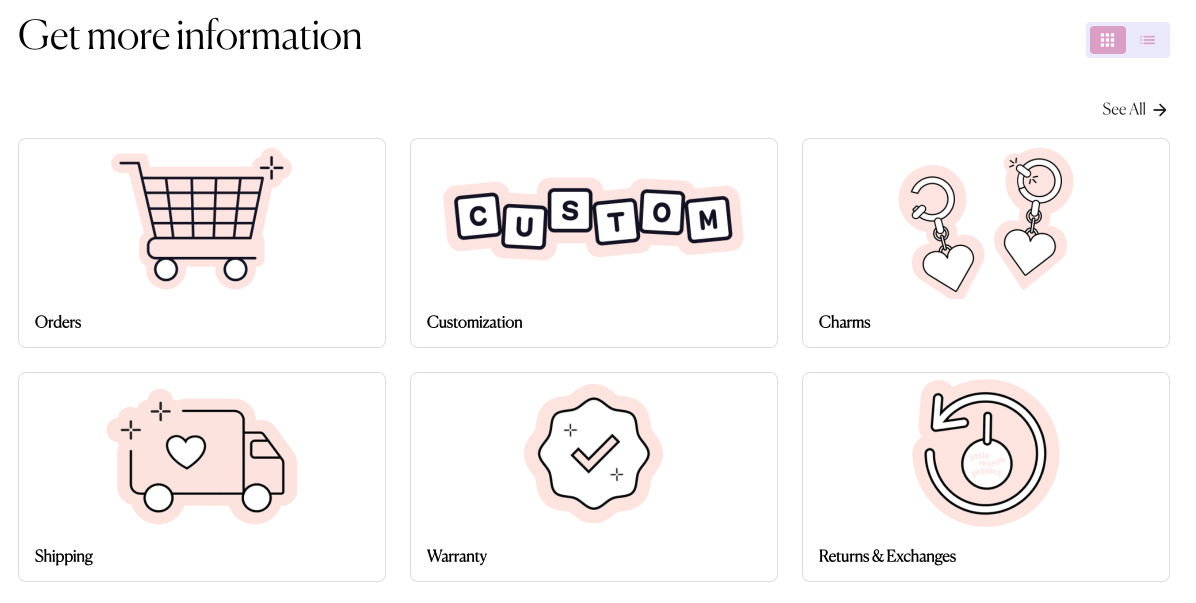
Dr. Bronner’s: Making tools work for the team
Customer education is at the heart of Dr. Bronner’s mission. Their customers often ask detailed questions about product ingredients, packaging, and certifications. With Gorgias, Emily and her team were able to build a robust Help Center that helped to proactively give this information.
The Help Center doesn't just provide information. The integration of interactive Flows, Order Management, and a Contact Form automation allowed Dr. Bronner’s to handle routine inquiries—such as order statuses—quickly and efficiently. These kinds of interactive elements are all possible out-of-the-box, no IT support needed.
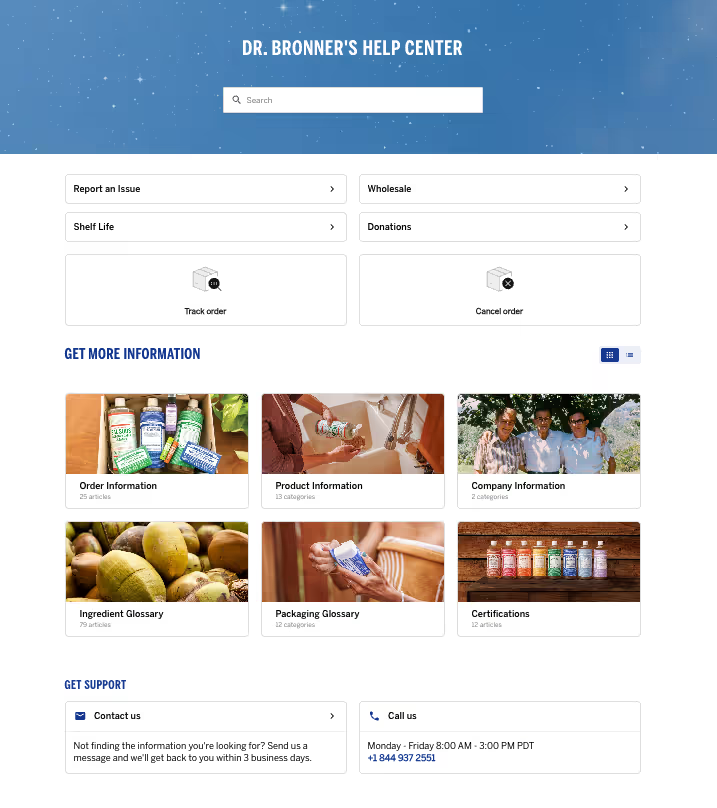
Ekster: Building efficiency through automation and clarity

When Ekster switched to Gorgias, the team wanted to make their Help Center work smarter. By writing clear, structured articles for common questions like order tracking, returns, and product details, they gave both customers and AI Agent the information needed to resolve issues instantly.
"Our previous Help Center solution was the worst. I hated it. Then I saw Gorgias’s Help Center features, and how the Article Recommendations could answer shoppers’ questions instantly, and I loved it. I thought: this is just what we need." —Shauna Cleary, Head of Ecommerce at Ekster
The results followed fast. With well-organized Help Center content and automation built around it, Ekster was able to scale support without expanding the team.
“With all the automations we’ve set up in Gorgias, and because our team in Buenos Aires has ramped up, we didn’t have to rehire any extra agents.” —Shauna Cleary, Head of Ecommerce at Ekster
Learn more: How Ekster used automation to cover the workload of 4 agents
Rowan: Clean structure that keeps customers (and AI) on track
Rowan’s Help Center is a great example of how clear structure can do the heavy lifting. Their FAQs are grouped into simple categories like piercing, shipping, returns, and aftercare, so readers and AI Agent can jump straight to the right topic without digging.
For LLMs, that kind of consistency reduces guesswork. For customers, it creates a smooth, reassuring self-service experience.
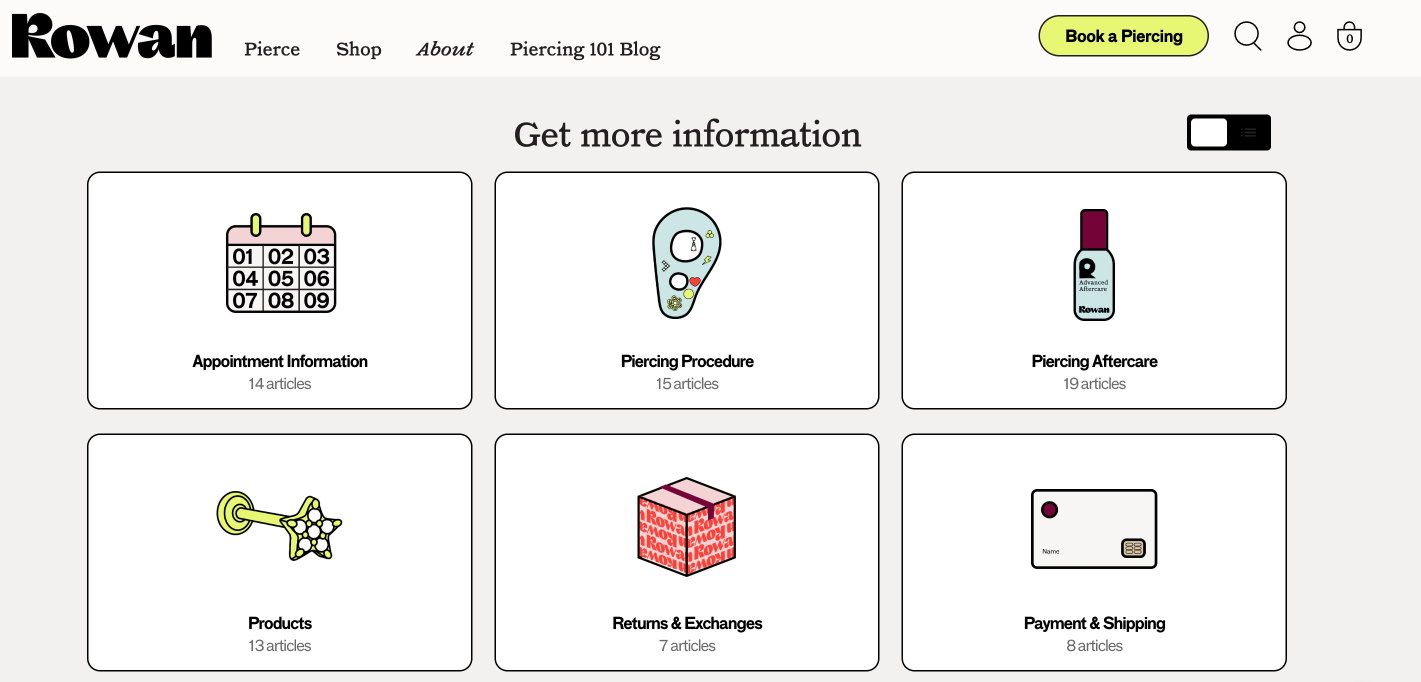
TUSHY: Balancing brand voice with automation
TUSHY proves you can maintain personality and structure. Their Help Center articles use clear headings, direct language, and brand-consistent tone. It makes it easy for AI Agent to give accurate, on-brand responses.
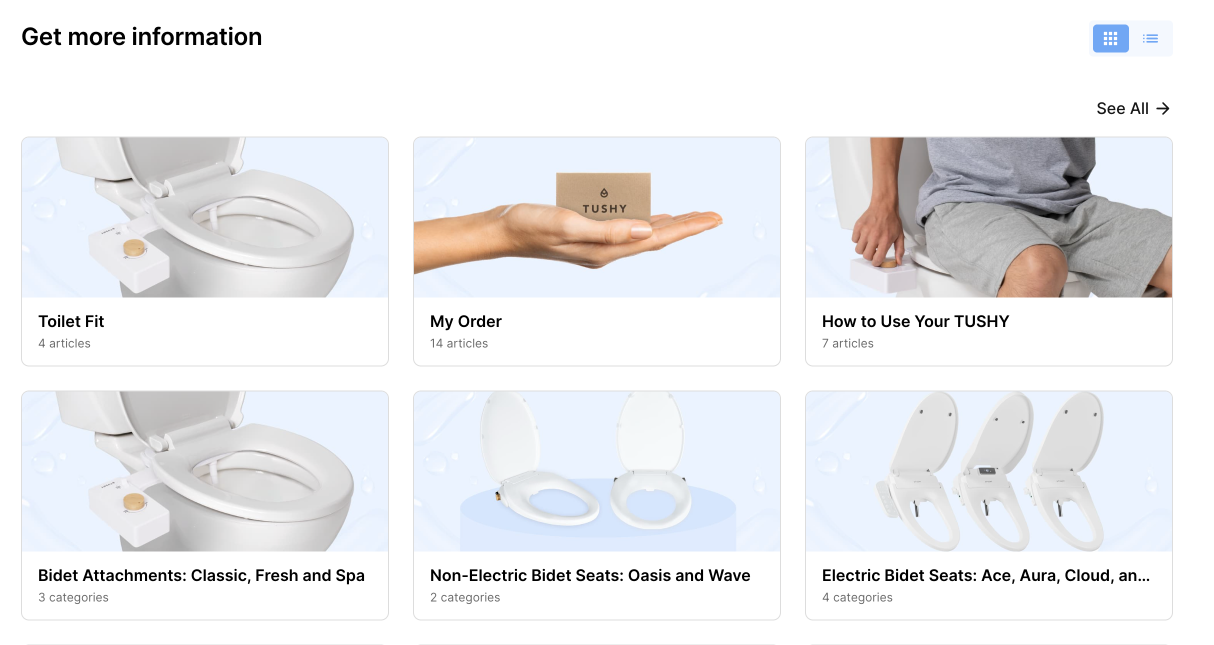
“Too often, a great interaction is diminished when a customer feels reduced to just another transaction. With AI, we let the tech handle the selling, unabashedly, if needed, so our future customers can ask anything, even the questions they might be too shy to bring up with a human. In the end, everybody wins!" —Ren Fuller-Wasserman, Senior Director of Customer Experience at TUSHY
Quick checklist to audit your Help Center for AI
Ready to put your Help Center to the test? Use this five-point checklist to make sure your content is easy for both customers and AI to navigate.
1. Are your articles scannable with clear headings?
Break up long text blocks and use descriptive headers (H2s, H3s) so readers and AI Agent can instantly find the right section.
2. Do you define conditions with “if/when/then” phrasing?
Spell out what happens in each scenario. This logic helps AI Agent decide the right next step without second-guessing.
3. Do you cover your top escalation topics?
Make sure your Help Center includes complete, structured articles for high-volume issues like order status, returns, and refunds.
4. Does each article end with a clear next step or link?
Close every piece with a call to action, like a form, related article, or support link, so neither AI nor customers hit a dead end.
5. Is your language simple, action-based, and consistent?
Use direct, predictable phrasing. Avoid filler like “Don’t worry!” and focus on steps customers can actually take.
By tweaking structure instead of your content, it’s easier to turn your Help Center into a self-service powerhouse for both customers and your AI Agent.
Make your Help Center work smarter
Your Help Center already holds the answers your customers need. Now it’s time to make sure AI can find them. A few small tweaks to structure and phrasing can turn your existing content into a powerful, AI-ready knowledge base.
If you’re not sure where to start, review your Help Center with your Gorgias rep or CX team. They can help you identify quick wins and show you how AI Agent pulls information from your articles.
Remember: AI Agent gets smarter with every structured doc you publish.
Ready to optimize your Help Center for faster, more accurate support? Book a demo today.
{{lead-magnet-2}}
Further reading

Celery + Gorgias
Celery just released their API on Github, currently in beta. Here are some of the cool stuff you can do with it in Gorgias.
Display customer information
When you receive an email from a customer, you can connect your Celery account and see customer information (orders, shipping address, etc.). Here’s what it looks like:

To configure it, grab your Celery access_token, head to integrations, and add an HTTP integration using this URL:
https://api.trycelery.com/v2/orders?buyer.email={ticket.requester.email}
Then you can customize the sidebar to only show the Celery data you need to respond to customers. Click the cog and simply drag and drop elements you want to show.

Refunds, order change... without leaving tickets
Celery’s API enables you to perform a few actions from your favorite helpdesk:
- Edit an order
- Cancel an order
- Issue a refund
- Create a coupon
Here’s an example of how you can cancel an order from Gorgias itself. Say you already have a macro to cancel an order. Add an HTTP action to it, in this case:
https://api.trycelery.com/v2/orders/{ticket.requester.customer.data[0].number}/order_cancel
Then, when you use this macro and send it to the customer, it will automatically cancel the last order at the same time:

We hope this integration with Celery can save you time. If you'd like to try Celery with Gorgias, shoot us a note! At support@gorgias.com.

PostgreSQL backup with pghoard & kubernetes
TLDR: https://github.com/xarg/pghoard-k8s
This is a small tutorial on how to do incremental backups using pghoard for your PostgreSQL (I assume you’re running everything in Kubernetes). This is intended to help people to get started faster and not waste time finding the right dependencies, etc..
pghoard is a PostgreSQL backup daemon that incrementally backups your files on a object storage (S3, Google Cloud Storage, etc..).
For this tutorial what we’re trying to achieve is to upload our PostgreSQL to S3.
First, let’s create our docker image (we’re using the alpine:3.4 image cause it’s small):
FROM alpine:3.4
ENV REPLICA_USER "replica"
ENV REPLICA_PASSWORD "replica"
RUN apk add --no-cache \
bash \
build-base \
python3 \
python3-dev \
ca-certificates \
postgresql \
postgresql-dev \
libffi-dev \
snappy-dev
RUN python3 -m ensurepip && \
rm -r /usr/lib/python*/ensurepip && \
pip3 install --upgrade pip setuptools && \
rm -r /root/.cache && \
pip3 install boto pghoard
COPY pghoard.json /pghoard.json.template
COPY pghoard.sh /
CMD /pghoard.sh
REPLICA_USER and REPLICA_PASSWORD env vars will be replaced later in your Kubernetes conf by whatever your config is in production, I use those values to test locally using docker-compose.
The config pghoard.json which tells where to get your data from and where to upload it and how:
{
"backup_location": "/data",
"backup_sites": {
"default": {
"active_backup_mode": "pg_receivexlog",
"basebackup_count": 2,
"basebackup_interval_hours": 24,
"nodes": [
{
"host": "YOUR-PG-HOST",
"port": 5432,
"user": "replica",
"password": "replica",
"application_name": "pghoard"
}
],
"object_storage": {
"aws_access_key_id": "REPLACE",
"aws_secret_access_key": "REPLACE",
"bucket_name": "REPLACE",
"region": "us-east-1",
"storage_type": "s3"
},
"pg_bin_directory": "/usr/bin"
}
},
"http_address": "127.0.0.1",
"http_port": 16000,
"log_level": "INFO",
"syslog": false,
"syslog_address": "/dev/log",
"syslog_facility": "local2"
}
Obviously replace the values above with your own. And read pghoard docs for more config explanation.
Note: Make sure you have enough space in your /data; use a Google Persistent Volume if you DB is very big.
Launch script which does 2 things:
- Replaces our ENV variables with the right username and password for our replication (make sure you have enough connections for your replica user)
- Launches the pghoard daemon.
#!/usr/bin/env bash
set -e
if [ -n "$TESTING" ]; then
echo "Not running backup when testing"
exit 0
fi
cat /pghoard.json.template | sed "s/\"password\": \"replica\"/\"password\": \"${REPLICA_PASSWORD}\"/" | sed "s/\"user\": \"replica\"/\"password\": \"${REPLICA_USER}\"/" > /pghoard.json
pghoard --config /pghoard.json
Once you build and upload your image to gcr.io you’ll need a replication controller to start your pghoard daemon pod:
apiVersion: v1
kind: ReplicationController
metadata:
name: pghoard
spec:
replicas: 1
selector:
app: pghoard
template:
metadata:
labels:
app: pghoard
spec:
containers:
- name: pghoard
env:
- name: REPLICA_USER
value: "replicant"
- name: REPLICA_PASSWORD
value: "The tortoise lays on its back, its belly baking in the hot sun, beating its legs trying to turn itself over. But it can't. Not with out your help. But you're not helping."
image: gcr.io/your-project/pghoard:latest
The reason I use a replication controller is because I want the pod to restart if it fails, if a simple pod is used it will stay dead and you’ll not have backups.
Future to do:
- Monitoring (are you backups actually done? if not, do you receive a notification?)
- Stats collection.
- Encryption of backups locally and then uploaded to the cloud (this is supported by pghoard).
Hope it helps, stay safe and sleep well at night.
Again, repo with the above: https://github.com/xarg/pghoard-k8s

Running Flask & Celery with Kubernetes
At Gorgias we recently switched our flask & celery apps from Google Cloud VMs provisioned with Fabric to using docker with kubernetes (k8s). This is a post about our experience doing this.
Note: I'm assuming that you're somewhat familiar with Docker.
Docker structure
The killer feature of Docker for us is that it allows us to make layered binary images of our app. What this means is that you can start with a minimal base image, then make a python image on top of that, then an app image on top of the python one, etc..
Here's the hierarchy of our docker images:
- gorgias/base - we're using phusion/baseimage as a starting base image.
- gorgias/pgbouncer
- gorgias/rabbitmq
- gorgias/nginx - extends gorgias/base and installs NGINX
- gorgias/python - Installs pip, python3.5 - yes, using it in production.
- gorgias/app - This installs all the system dependencies: libpq, libxml, etc.. and then does pip install -r requirements.txt
- gorgias/web - this sets up uWSGI and runs our flask app
- gorgias/worker - Celery worker
Piece of advice: If you used to run your app using supervisord before I would advise to avoid the temptation to do the same with docker, just let your container crash and let k8s handle it.
Now we can run the above images using: docker-compose, docker-swarm, k8s, Mesos, etc...
We chose Kubernetes too
There is an excellent post about the differences between container deployments which also settles for k8s.
I'll also just assume that you already did your homework and you plan to use k8s. But just to put more data out there:
Main reason: We are using Google Cloud already and it provides a ready to use Kubernetes cluster on their cloud.
This is huge as we don't have to manage the k8s cluster and can focus on deploying our apps to production instead.
Let's begin by making a list of what we need to run our app in production:
- Database (Postgres)
- Message queue (RabbitMQ)
- App servers (uWSGI running Flask)
- Web servers (NGINX proxies uWSGI and serves static files)
- Workers (celery)
Why Kubernetes again?
We ran the above in a normal VM environment, why would we need k8s? To understand this, let's dig a bit into what k8s offers:
- A pod is a group of containers (docker, rtk, lxc...) that runs on a Node. It's a group because sometimes you want to run a few containers next to each other. For example we are running uWSGI and NGINX on the same pod (on the same VM and they share the same ip, ports, etc..).
- A Node is a machine (VM or metal) that runs a k8s daemon (minion) that runs the Pods.
- The nodes are managed by the k8s master (which in our case is managed by the container engine from Google).
- Replication Controller or for short rc tells k8s how many pods of a certain type to run. Note that you don't tell k8s where to run them, it's master's job to schedule them. They are also used to do rolling updates, and autoscaling. Pure awesome.
- Services take the exposed ports of your Pods and publishes them (usually to the Public). Now what's cool about a service that it can load-balance the connections to your pods, so you don't need to manage your HAProxy or NGINX. It uses labels to figure out what pods to include in it's pool.
- Labels: The CSS selectors of k8s - use them everywhere!
-
There are more concepts like volumes, claims, secrets, but let's not worry about them for now.
Postgres
We're using Postgres as our main storage and we are not running it using Kubernetes.
Now we are running postgres in k8s (1 hot standby + pghoard), you can ignore the rest of this paragaph.
The reason here is that we wanted to run Postgres using provisioned SSD + high memory instances. We could have created a cluster just for postgres with these types of machines, but it seemed like an overkill.
The philosophy of k8s is that you should design your cluster with the thought that pods/nodes of your cluster are just gonna die randomly. I haven't figured our how to setup Postgres with this constraint in mind. So we're just running it replicated with a hot-standby and doing backups with wall-e for now. If you want to try it with k8s there is a guide here. And make sure you tell us about it.
RabbitMQ
RabbitMQ (used as message broker for Celery) is running on k8s as it's easier (than Postgres) to make a cluster. Not gonna dive into the details. It's using a replication controller to run 3 pods containing rabbitmq instances. This guide helped: https://www.rabbitmq.com/clustering.html
uWSGI & NGINX
As I mentioned before, we're using a replication controller to run 3 pods, each containing uWSGI & NGINX containers duo: gorgias/web & gorgias/nginx. Here's our replication controller web-rc.yaml config:
apiVersion: v1
kind: ReplicationController
metadata:
name: web
spec:
replicas: 3 # how many copies of the template below we need to run
selector:
app: web
template:
metadata:
labels:
app: web
spec:
containers:
- name: web
image: gcr.io/your-project/web:latest # the image that you pushed to Google Container Registry using gcloud docker push
ports: # these are the exposed ports of your Pods that are later used by the k8s Service
- containerPort: 3033
name: "uwsgi"
- containerPort: 9099
name: "stats"
- name: nginx
image: gcr.io/your-project/nginx:latest
ports:
- containerPort: 8000
name: "http"
- containerPort: 4430
name: "https"
volumeMounts: # this holds our SSL keys to be used with nginx. I haven't found a way to use the http load balancer of google with k8s.
- name: "secrets"
mountPath: "/path/to/secrets"
readOnly: true
volumes:
- name: "secrets"
secret:
secretName: "ssl-secret"
And now the web-service.yaml:apiVersion: v1
kind: Service
metadata:
name: web
spec:
ports:
- port: 80
targetPort: 8000
name: "http"
protocol: TCP
- port: 443
targetPort: 4430
name: "https"
protocol: TCP
selector:
app: web
type: LoadBalancer
That type: LoadBalancer at the end is super important because it tells k8s to request a public IP and route the network to the Pods with the selector=app:web.
If you're doing a rolling-update or just restarting your pods, you don't have to change the service. It will look for pods matching those labels.
Celery
Also a replication controller that runs 4 pods containing a single container: gorgias/worker, but doesn't need a service as it only consumes stuff. Here's our worker-rc.yaml:
apiVersion: v1
kind: ReplicationController
metadata:
name: worker
spec:
replicas: 2
selector:
app: worker
template:
metadata:
labels:
app: worker
spec:
containers:
- name: worker
image: gcr.io/your-project/worker:latest
Some tips
- Installing some python deps take a long time, for stuff like numpy, scipy, etc.. try to install them in your namespace/app container using pip and then do another pip install in the container that extends it, ex: namespace/web, this way you don't have to rebuild all the deps every time you update one package or just update your app.
- Spend some time playing with gcloud and kubectl. This will be the fastest way to learn of google cloud and k8s.
- Base image choice is important. I tried phusion/baseimage and ubuntu/core. Settled for phusion/baseimage because it seems to handle the init part better than ubuntu core. They still feel too heavy. phusion/baseimage is 188MB.
Conclusion
With Kubernetes, docker finally started to make sense to me. It's great because it provides great tools out of the box for doing web app deployment. Replication controllers, Services (with LoadBalancer included), Persistent Volumes, internal DNS. It should have all you need to make a resilient web app fast.
At Gorgias we're building a next generation helpdesk that allows responding 2x faster to common customer requests and having a fast and reliable infrastructure is crucial to achieve our goals.
If you're interested in working with this kind of stuff (especially to improve it): we're hiring!

New navigation & template sharing in the Extension
We've released a new version of the Chrome Extension, with sharing features and a new navigation bar. We hope you'll love it!
Share templates inside the extension
Before, the only way to share templates with your teammates was to login on Gorgias.io.
If you're on the startup plan, when you create a template, you can choose who has access to it: either only you, specific people, or your entire team.

The account management section is now available in the extension, under settings.
New navigation
Tags are now available on the left. It's easier to manage hundreds of templates with them.
You can also navigate through your private & shared templates. Shared templates include templates shared with specific people or with everyone.

We hope you'll enjoy this new version of our Chrome Extension. As usual, your feedback & questions are welcome!

We've raised a Seed Round!
Today, we’re thrilled to announce that we’ve raised a $1.5 million Seed round led by Charles River Ventures and Amplify Partners, to help build our new helpdesk.
We’re incredibly grateful to early users, customers, mentors we’ve met both at and Techstars.
We started the journey with Alex at the beginning of 2015 with our Chrome extension, which helps write email faster using templates. We’ve been pleased all along with customers telling us about how helpful it was, especially for customer support.
While building the extension, we’ve realized that a big inefficiency in support lies in the lack of integration between the helpdesk, the payment system, CRM and other tools support is using. As a result, agents need to do a lot of repetitive work to respond to customer requests, especially when the company is big.

That’s why we’ve decided to build a new kind of helpdesk to enable customer support agents to respond 2x faster to customers. You can find out more and sign up for our private beta here.
When a company has a lot of customers, support becomes repetitive. We want to provide support teams with tools to automate the way they treat simple repetitive requests. This way, they have more time for complex customer issues.
We'll now focus on this helpdesk and on growing the team, oh, and if you'd like to join, we're hiring! We're super excited about this new helpdesk product. If you’re using the extension, don’t worry.
Romain & Alex

Outlook support & New editor
We've been busy, but not deaf!
Last few months we got lots of feedback about our extension and found to our delight that most people are satisfied, but still a few recurrent issues came up:
- The HTML/WYSIWYG editor sucks.
- No support for Outlook.com.
We listened and now we're presenting:
- A brand new editor
- Support for outlook.com
- More on the Rich-Text editor
WYSIWYG editors for the web are notoriously buggy and are just difficult to develop.
I have yet to see one that is bug free. There are few venerable editors that do a good job like TinyMCE, FKEditor or CKEditor.. but they are big and all have edge cases that break the intended formatting and add a lot of garbage html.
There are newer good quality editors in town such as Redactor. The one that got my attention and finally landed in Gorgias is this wonderful editor called which is super lightweight, uses modern content-editable (no i-frames) and 'just works' most of the time. That's not to say it's perfect, but it's good enough and I'm satisfied with it's direction in terms of development.
Enjoy it and as always send us bug-reports or feedback on: support@gorgias.com

Your Support Team Drives More Revenue Than You Think: Conversational Commerce Metrics
TL;DR:
- Support chats can now be directly tied to revenue. Brands are measuring conversations by conversion rate, average order value (AOV), and GMV influenced.
- AI resolution rate is only valuable if the answers are accurate and helpful. A high resolution rate doesn’t matter if it leads to poor recommendations — the best AI both deflects volume and drives confident purchases.
- Chat conversion rates often outperform traditional channels. Brands like Arc’teryx saw a 75% lift in conversions (from 4% to 7%) when AI handled high-intent product questions.
- Shoppers who chat often spend more. Conversations lead to higher AOVs by helping customers understand products, explore upgrades, and discover add-ons — not just through upselling, but smarter guidance.
Conversational commerce finally has a scoreboard.
For years, CX leaders knew support conversations mattered, they just couldn’t prove how much. Conversations lived in that gray area of ecommerce where shoppers got answers, agents did their best, and everyone agreed the channel was “important”…
But tying those interactions back to actual revenue? Nearly impossible.
Fast forward to today, and everything has changed.
Real-time conversations — whether handled by a human agent or powered by AI — now leave a measurable footprint across the entire customer journey. You can see how many conversations directly influenced a purchase.
In other words, conversational commerce is finally something CX teams can measure, optimize, and scale with confidence.
Why measuring conversational commerce matters now
If you want to prove the value of your CX strategy to your CFO, your marketing team, or your CEO, you need data, not anecdotes.
Leadership isn’t swayed by “We think conversations help shoppers.” They want to see the receipts. They want to know exactly how interactions influence revenue, which conversations drive conversion, and where AI meaningfully reduces workload without sacrificing quality.
That’s why conversational commerce metrics matter now more than ever. This gives CX leaders a way to:
- Quantify the revenue influence of conversations
- Understand where AI improves efficiency — and where humans add the most value
- Make informed decisions on staffing, automation, and channel investment
- Turn CX into a profit center instead of a cost center
These metrics let you track impact with clarity and confidence.
And once you can measure it, you can build a stronger case for deeper investment in conversational tools and strategy.
The 4 metric categories that define conversational commerce success
So, what exactly should CX teams be measuring?
While conversational commerce touches every part of the customer journey, the most meaningful insights fall into four core categories:
- Automation performance
- Conversion & revenue impact
- Engagement quality
- Discounting behavior
Let’s dive into each.
Automation performance metrics
If you want to understand how well your conversational commerce strategy is working, automation performance is the first place to look. These metrics reveal how effectively AI is resolving shopper needs, reducing ticket volume, and stepping into revenue-driving conversations at scale.
The two most foundational metrics?
1. Resolution rate: Are AI-led conversations actually helpful?
Resolution rate measures how many conversations your AI handles from start to finish without needing a human to take over. On paper, high resolution rates sound like a guaranteed win. It suggests your AI is handling product questions, sizing concerns, shade matching, order guidance, and more — all without adding to your team’s workload.
But a high resolution rate doesn’t automatically mean your AI is performing well.
Yes, the ticket was “resolved,” but was the customer actually helped? Was the answer accurate? Did the shopper leave satisfied or frustrated?
This is where quality assurance becomes essential. Your AI should be resolving tickets accurately and helpfully, not simply checking boxes.
At its best, a strong resolution rate signals that your AI is:
- Confidently answering product questions
- Guiding shoppers to the right SKU, variant, shade, size, or style
- Reducing cart abandonment caused by confusion
- Helping pre-sale shoppers convert faster
When resolution rate quality goes up, so does revenue influence.
You can see this clearly with beauty brands, where accuracy matters enormously. bareMinerals, for example, used to receive a flood of shade-matching questions. Everything from “Which concealer matches my undertone?” to “This foundation shade was discontinued; what’s the closest match?”
Before AI, these questions required well-trained agents and often created inconsistencies depending on who answered.
Once they introduced Shopping Assistant, resolution rate suddenly became more meaningful. AI wasn’t just closing tickets; it was giving smarter, more confident recommendations than many agents could deliver at scale, especially after hours.

That accuracy paid off.
AI-influenced purchases at bareMinerals had zero returns in the first 30 days because customers were finally getting the right shade the first time.
That’s the difference between “resolved” and resolved well.
2. Zero-touch tickets: How many tickets never reach a human?
The zero-touch ticket rate measures something slightly different: the percentage of conversations AI manages entirely on its own, without ever being escalated to an agent.
This metric is a direct lens into:
- Workload reduction
- Team efficiency
- Cost savings
- AI’s ability to own high-volume question types
More importantly, deflection widens the funnel for more revenue-driven conversations.
When AI deflects more inbound questions, your support team can focus on conversations that truly require human expertise, including returns exceptions, escalations, VIP shoppers, and emotionally sensitive interactions.
Brands with strong deflection rates typically see:
- Shorter wait times
- Higher CSAT
- Lower support costs
- More AI-influenced revenue
Conversion and revenue impact metrics
If automation metrics tell you how well your AI is working, conversion and revenue metrics tell you how well it’s selling.
This category is where conversational commerce really proves its value because it shows the direct financial impact of every human- or AI-led interaction.
1. Chat Conversion Rate (CVR): How often do conversations turn into purchases?
Chat conversion rate measures the percentage of conversations that end in a purchase, and it’s one of the clearest indicators of whether your conversational strategy is influencing shopper decisions.
A strong CVR tells you that conversations are:
- Building confidence
- Removing hesitation
- Guiding shoppers toward the right product
You see this clearly with brands selling technical or performance-driven products.
Outdoor apparel shoppers, for example, don’t just need “a jacket” — they need to know which jacket will hold up in specific temperatures, conditions, or terrains. A well-trained AI can step into that moment and convert uncertainty into action.
Arc’teryx saw this firsthand.

Once Shopping Assistant started handling their high-intent pre-purchase questions, their chat conversion rate jumped dramatically — from 4% to 7%. A 75% lift.
That’s what happens when shoppers finally get the expert guidance they’ve been searching for.
2. GMV influenced: The revenue ripple effect of conversations
Not every shopper buys the moment they finish a chat. Some take a few hours. Some need a day or two. Some want to compare specs or read reviews before committing.
GMV influenced captures this “tail effect” by tracking revenue within 1–3 days of a conversation.
It’s especially powerful for:
- High-consideration purchases (like outdoor gear, home furniture, equipment)
- Products with many options, specs, or configurations
- Shoppers who need reassurance before buying
In Arc’teryx’s case, shoppers often take time to confirm they’re choosing the right technical gear.
Yet even with that natural pause in behavior, Shopping Assistant still influenced 3.7% of all revenue, not by forcing instant decisions, but by providing the clarity people needed to make the right one.
3. AOV from conversational commerce: Do conversations lead to bigger carts?
This metric looks at the average order value of shoppers who engage in a conversation versus those who don’t.
If the conversational AOV is higher, it means your AI or agents are educating customers in ways that naturally expand the cart.
Examples of AOV-lifting conversations include:
- Recommending complementary gear, tools, or accessories
- Suggesting upgraded options based on needs
- Helping shoppers understand the difference between product tiers
- Explaining why a specific product is worth the investment
When conversations are done well, AOV increases not because shoppers are being upsold, but because they’re being guided.
4. ROI of AI-powered conversations: The metric your leadership cares most about
ROI compares the revenue generated by conversational AI to the cost of the tool itself — in short, this is the number that turns heads in boardrooms.
Strong ROI shows that your AI:
- Does the work of multiple agents
- Drives new revenue, not just ticket deflection
- Provides accurate answers consistently, at any time
- Delivers a high-quality experience without expanding headcount
When ROI looks like that, AI stops being a “tool” and starts being an undeniable growth lever.
Related: The hidden power and ROI of automated customer support
Engagement metrics that indicate purchase intent
Not every metric in conversational commerce is a final outcome. Some are early signals that show whether shoppers are interested, paying attention, and moving closer to a purchase.
These engagement metrics are especially valuable because they reveal why conversations convert, not just whether they do. When engagement goes up, conversion usually follows.
1. Click-Through Rate (CTR): Are shoppers acting on the products your AI recommends?
CTR measures the percentage of shoppers who click the product links shared during a conversation. It’s one of the cleanest leading indicators of buyer intent because it reflects a moment where curiosity turns into action.
If CTR is high, it’s a sign that:
- Your recommendations are relevant
- The conversation is persuasive
- The shopper trusts the guidance they’re getting
- The AI is surfacing the right product at the right time
In other words, CTR tells you which conversations are influencing shopping behavior.
And the connection between CTR and revenue is often tighter than teams expect.
Just look at what happened with Caitlyn Minimalist. When they began comparing the results of human-led conversations versus AI-assisted ones over a 90-day period, CTR became one of the clearest predictors of success. Their Shopping Assistant consistently drove meaningful engagement with its recommendations — an 18% click-through rate on the products it suggested.
That level of engagement translated directly into better outcomes:
- AI-driven conversations converted at 20%, compared to just 8% for human agents
- Many of those clicks led to multi-item purchases
- Overall, the brand experienced a 50% lift in sales from AI-assisted chats compared to human-only ones
When shoppers click, they’re moving deeper into the buying cycle. Strong CTR makes it easier to forecast conversion and understand how well your conversational flows are guiding shoppers toward the right products.

Discounting behavior metrics
Discounting can be one of the fastest ways to nudge a shopper toward checkout, but it’s also one of the fastest ways to erode margins.
That’s why discount-related metrics matter so much in conversational commerce.
They show not just whether AI is using discounts, but how effectively those discounts are driving conversions.
1. Discounts offered: Are incentives being used strategically or too often?
This metric tracks how many discount codes or promotional offers your AI is sharing during conversations.
Ideally, discounts should be purposeful — timed to moments when a shopper hesitates or needs an extra nudge — not rolled out as a one-size-fits-all script. When you monitor “discounts offered,” you can ensure that incentives are being used as conversion tools, not crutches.
This visibility becomes particularly important at high-intent touchpoints, such as exit intent or cart recovery interactions, where a small incentive can meaningfully increase conversion if used correctly.
2. Discounts applied: Are those discounts actually influencing the purchase?
Offering a discount is one thing. Seeing whether customers use it is another.
A high “discounts applied” rate suggests:
- The offer was compelling
- The timing was right
- The shopper truly needed that incentive to convert
A low usage rate tells a different story: Your team (or your AI) is discounting unnecessarily.
This metric alone often surprises brands. More often than not, CX teams discover they can discount less without hurting conversion, or that a non-discount incentive (like a relevant product recommendation) performs just as well.
Understanding this relationship helps teams tighten their promotional strategy, protect margins, and use discounts only where they actually drive incremental revenue.
How CX teams use these metrics to make better decisions
Once you know which metrics matter, the next step is building a system that brings them together in one place.
Think of your conversational commerce scorecard as a decision-making engine — something that helps you understand performance at a glance, spot bottlenecks, optimize AI, and guide shoppers more effectively.
In Gorgias, you can customize your analytics dashboard to watch the metrics that matter most to your brand. This becomes the single source of truth for understanding how conversations influence revenue.
Here’s what a powerful dashboard unlocks:
1. You learn where AI performs best (and where humans outperform)
Some parts of the customer journey are perfect for AI: repetitive questions, product education, sizing guidance, shade matching, order status checks.
Others still benefit from human support, like emotional conversations, complex troubleshooting, multi-item styling, or high-value VIP concerns.
Metrics like resolution rate, zero-touch ticket rate, and chat conversion rate show you exactly which is which.
When you track these consistently, you can:
- Identify conversation types AI should fully own
- Spot where AI needs more training
- Allocate human agents to higher-value conversations
- Decide when humans should step in to drive stronger outcomes
For example, if AI handles 80% of sizing questions successfully but struggles with multi-item styling advice, that tells you where to invest in improving AI, and where human expertise should remain the default.
2. You uncover what shoppers actually need to convert
Metrics like CTR, CVR, and conversational AOV reveal the inner workings of shopper decision-making. They show which recommendations resonate, which don’t, and which messaging actually moves someone to purchase.
With these insights, CX teams can:
- Refine product recommendations
- Improve conversation flows that stall out
- Adjust the tone or structure of AI messaging
- Draft stronger scripts for human agents
- Identify recurring questions that indicate missing PDP information
For instance, if shoppers repeatedly ask clarifying questions about a product’s material or fit, that’s a signal for merchandising or product teams.
If recommendations with social proof get high engagement, marketing can integrate that insight into on-site messaging.
Conversations reveal what customers really care about — often before analytics do.
3. You prove that conversations directly drive revenue
This is the moment when the scorecard stops being a CX tool and becomes a business tool.
A clear set of metrics shows how conversations tie to:
- GMV influenced
- AOV lift
- Revenue generated by AI
- ROI of conversational commerce tools
When a CX leader walks into a meeting and says, “Our AI Assistant influenced 5% of last month’s revenue” or “Conversational shoppers have a 20% higher AOV,” the perception of CX changes instantly.
You’re no longer a support cost. You’re a revenue channel.
And once you have numbers like ROI or revenue influence in hand, it becomes nearly impossible for anyone to argue against further investment in CX automation.
4. You identify where shoppers are dropping off or hesitating
A scorecard doesn’t just show what’s working, it surfaces what’s not.
Metrics make friction obvious:
Metric Signal |
What It Means |
|---|---|
Low CTR |
Recommendations may be irrelevant or poorly timed. |
Low CVR |
Conversations aren’t persuasive enough to drive a purchase. |
High deflection but low revenue |
AI is resolving tickets, but not effectively selling. |
High discount usage |
Shoppers rely on incentives to convert. |
Low discount usage |
You may be offering discounts unnecessarily and losing margin. |
Once you identify these patterns, you can run targeted experiments:
- Test new scripts or flows
- Adjust product recommendations
- Add social proof or benefit framing
- Reassess discounting strategies
- Rework messaging on key PDPs
Compounded over time, these moments create major lifts in conversion and revenue.
5. You create a feedback loop across marketing, merchandising, and product
One of the biggest hidden values of conversational data is how it strengthens cross-functional decision-making.
A clear analytics dashboard gives teams visibility into:
- Unclear or missing product information (from repeated questions)
- Merchandising opportunities (from your most popular products)
- Landing page or PDP improvements (from drop-off points)
- Messaging that resonates with real customers (from AI messages)
Suddenly, CX isn’t just answering questions — it’s informing strategy across the business.
CX drives revenue when you measure what matters
With the right metrics in place, CX leaders can finally quantify the impact of every interaction, and use that data to shape smarter, more profitable customer journeys.
If you're ready to measure — and scale — the impact of your conversations, tools like Gorgias AI Agent and Shopping Assistant give CX teams the visibility, accuracy, and performance needed to turn every interaction into revenue.
Want to see it in action? Book a demo and discover what conversational commerce can do for your bottom line.
{{lead-magnet-2}}

AI Hallucinations: What Support Teams Need to Know
TL;DR:
- AI hallucinations happen when AI models create false information that sounds real.
- They occur in customer support when chatbots lack proper training data or face unclear questions.
- Main causes include bad training data, overfitting, and confusing prompts. You can prevent them by grounding responses in real data, setting clear limits, and keeping humans in the loop.
- When managed right, AI reduces support tickets while staying accurate and on-brand.
Your AI chatbot just told a customer their order ships in two days when you actually need five. That's an AI hallucination, or false information delivered with complete confidence.
These fake-but-convincing responses can wreck customer trust and create headaches for your support team. Understanding what triggers these AI mistakes and how to stop them matters for any brand using AI in customer service.
This guide covers everything support teams need to know about AI hallucinations, from spotting them to building systems that keep your AI honest and helpful.
{{lead-magnet-1}}
What are AI hallucinations?
AI hallucinations are false or made-up responses from AI models that sound completely believable. This means the AI creates information that isn't based on real data but presents it like it's a fact.
The term “hallucination” comes from psychology, but AI hallucinations work differently than human ones. When an AI hallucinates, it's not seeing things that aren't there. Instead, it's filling gaps in its knowledge with creative guesswork.
Large language models (LLMs) power most modern chatbots. These models predict what word comes next based on patterns they learned during training. Sometimes they predict wrong and create entirely made-up information.
The real problem isn't that AI makes mistakes — it's how confidently it delivers wrong answers. Your AI won't say “I think” or “maybe.” It states false information with authority, making errors hard to catch.
For your ecommerce brand, this could mean your chatbot invents return policies or confirms products are in stock when they're not. These confident lies break customer trust and force your human agents to clean up the mess.
What causes AI hallucinations
AI hallucinations are baked into how current models function, caused by training data limitations, missing context, and statistical prediction errors that lead AI to invent convincing but false answers. Knowing why they happen helps you prevent them in your customer support.
Insufficient training data creates the biggest problems. When you ask AI about topics it hasn't learned, it tries to fill knowledge gaps with educated guesses. These guesses often sound reasonable but are completely wrong.
Overfitting happens when AI memorizes training examples instead of learning patterns. The model becomes an expert at repeating what it's seen before but terrible at handling new situations.
Ambiguous prompts confuse AI models. When customers ask vague questions that could mean several things, AI picks one interpretation and runs with it.
Outdated information causes problems because most AI models have knowledge cutoffs. They don't know about new promotions, products, or policy changes after their training ended. Your AI might confidently share old shipping times or discontinued product details.
Pattern misapplication occurs when AI applies learned patterns to wrong situations. The model recognizes linguistic patterns and uses them inappropriately, creating responses that sound right but make no sense in context.
Examples of AI hallucinations in customer support
AI hallucinations create real problems for support teams. When chatbots hallucinate, human agents spend time fixing the damage instead of helping customers with genuine needs.
Here are common ways AI hallucinates in ecommerce support:
- Product feature invention: Customer asks if a jacket is waterproof. AI confidently says "Yes, it's fully waterproof and tested to 10 feet underwater" when it's only water-resistant.
- Fake discount codes: Shopper requests a discount. AI creates "SAVE20NOW" — a realistic-sounding but non-existent code that fails at checkout.
- Wrong return windows: AI tells customers they have 60 days to return items because it hasn’t been fed your return policy, creating expectations you can't meet.
- Fabricated shipping promises: AI promises next-day delivery for standard shipping orders, setting impossible expectations.
- Invented company policies: Customer asks about price matching. AI creates a detailed policy you've never offered, forcing agents to disappoint customers.
Each hallucination creates a cascade of problems. Customers get frustrated when promises don't match reality. Your support team wastes time explaining why the AI was wrong. Your brand reputation takes a hit when customers can't trust your automated responses.
The worst part? These hallucinations often sound more helpful than honest answers. An AI that says “I don't know” seems less useful than one that confidently provides detailed (but wrong) information.
How to prevent AI hallucinations in customer support
You can't eliminate AI hallucinations completely, but you can reduce them. The key is moving from pure text generation to grounded, controlled responses based on your real data.
Limit possible outcomes
Instead of letting AI create any response it wants, give it specific options to choose from. For common questions about returns or shipping, create approved response categories. This prevents AI from inventing policies on the spot.
Decision trees work well for this approach. When customers ask about returns, your AI follows a predetermined path: check order date, verify product type, provide appropriate response. No creativity required.
You can also set response templates for frequent questions. Templates include placeholders for customer names or order numbers while keeping core information consistent and accurate.
Related: How to write Guidance with the “when, if, then” framework
Train models on relevant data
Generic AI training creates generic problems. Train your AI specifically on your business data — past support tickets, verified Help Center articles, and current product information.
Your training data should include:
- Real customer conversations: Use actual support tickets to teach AI how customers ask questions and what answers work
- Current product catalogs: Keep AI updated on what you actually sell, not what it thinks you might sell
- Verified policies: Only include official company policies, not industry standards or competitor information
- Brand voice examples: Show AI how your team actually talks to customers
- Your public Help Center: Use the resources you already provide to customers to teach it your most-asked questions
Quality matters more than quantity. It’s better to train on 1,000 accurate examples than 10,000 low-quality ones.
Create response templates
Templates give AI structure while allowing personalization. Instead of generating responses from scratch, AI fills in blanks within approved frameworks.
A shipping template might look like:
- "Hi [customer name], your order [order number] shipped on [ship date] and will arrive by [delivery date]. Track it here: [tracking link]."
Templates ensure consistency across all AI responses. Customers get the same quality information whether they chat at 2 pm or 2 am. Your brand voice stays consistent even when AI handles the conversation.
Tell the model what to include and exclude
Set explicit boundaries for your AI through system prompts and instructions. Create lists of topics that always need human agents, like product safety complaints or legal threats.
Specify which information sources AI can use. Point it toward your Help Center and product database while blocking access to general internet information that might be outdated or irrelevant.
You can also create escalation triggers. When AI encounters certain keywords or question types, it automatically passes the conversation to a human agent instead of guessing.
Test and refine the system
AI isn't a set-it-and-forget-it tool. Regular testing catches problems before customers do.
Set up quality checks on AI responses. Review a sample of conversations weekly to spot inaccuracies or areas for improvement. Look for patterns in escalated tickets — they often reveal gaps in AI training.
A/B testing helps optimize AI performance. Try different prompt configurations to see which produces more accurate responses. Monitor customer satisfaction scores for AI-handled tickets compared to human-handled ones.
Customer feedback provides valuable insights. When customers report AI errors, use those examples to improve training data and refine response templates.
Add human oversight and escalation
Build safety nets into your AI system. Set confidence thresholds so the AI only responds when it's confident in its answer. Uncertain responses get escalated to human agents automatically.
Create clear escalation paths for complex issues. AI should recognize when questions go beyond its capabilities and smoothly transfer customers to appropriate team members.
Human oversight doesn't mean micromanaging every AI response. Instead, focus on monitoring patterns and intervening when AI consistently struggles with specific questions.
Ground answers in Shopify and help center data
This strategy delivers the biggest impact for ecommerce brands. Grounding means forcing AI to base responses on verified, real-time data from your tech stack.
When customers ask about order status, grounded AI checks live Shopify data instead of guessing. When they ask about policies, it pulls exact text from your Help Center instead of paraphrasing from memory.
Grounding transforms AI from a creative writer into a reliable assistant. It can only share information that exists in your approved systems, dramatically reducing hallucination risk.
Integration with your ecommerce platform ensures AI always has current information about inventory, shipping, and customer orders. No more promising products you don't have or delivery dates you can't meet.
Turn AI accuracy into competitive advantage
The brands winning with AI have put in the hours to train it. They've built systems that combine AI efficiency with human oversight, creating customer experiences that feel both fast and trustworthy.
Gorgias AI Agent demonstrates this approach in action. It grounds responses in your Shopify data and Help Center content, ensuring every automated interaction reflects your actual business information. Customizable guardrails let you set boundaries while maintaining the speed customers expect.
Ready to see how accurate AI can transform your support operations? Book a demo and discover how to automate customer service without sacrificing quality or control.
{{lead-magnet-2}}

Building delightful customer interactions starts in your inbox



